
Economy GREEN journal ISSUE 57 | 2023 INTERVIEW WITH SAPVIA CEO 24 WIND TURBINE SOURCING 30 INFRASTRUCTURE: ARRESTED DEVELOPMENT? 44 Just Energy Transition for AFRICA
Strive for Net Zero while saving money at the same time!
Rooftop, solar car-ports, ground mounted solar, and agri-voltaics represent the best value energy available to the energy customer in South Africa.
Blue Sky Energy are experts in the design, procurement and construction of such plants. Battery energy storage installations provide access to solar energy daily during peak hours when the sun is not shining and enable users to bridge their primary energy needs through grid interruptions. While the levelised cost of hybrid solar + battery storage installations is significantly greater than solar PV only, appropriately sized solutions can be commercially feasible. Would you like to know if your property or business can achieve energy security at the same cost or less than what you are paying currently?
Agri-Voltaics and Solar Car Ports
Blue Sky Energy works with leading light steel frame construction suppliers to offer a range of innovative solutions such as agrivoltaics and solar car-ports.
Have you considered putting your spare space to work? Whether you have low value land or large parking spaces, bring them to life through solar PV installations that create energy and high value spaces such as shade for parking or tunnels for agriculture.

Website: www.blue-sky.energy Email: enquiries@blue-sky.energy
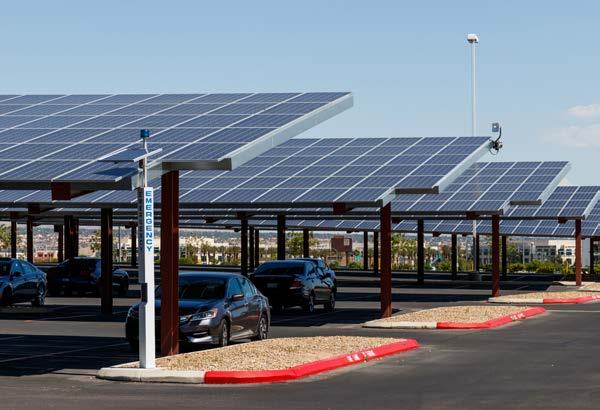
123RF
Did you know that Section 12B of the Tax Act allows for the accelerated depreciation of your power generation capex resulting in a 27.5% saving on your project installation?


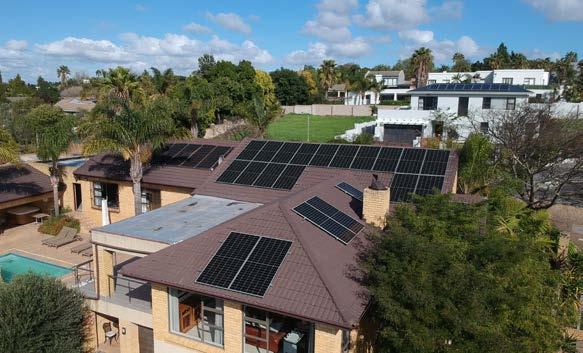
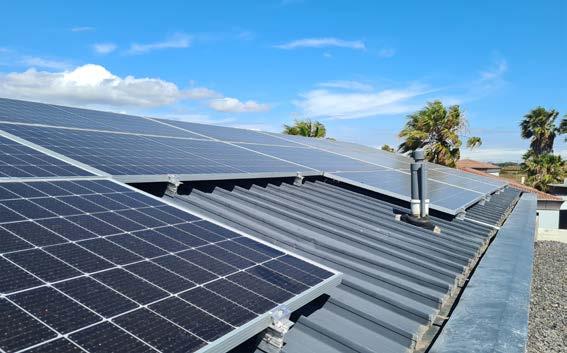

CONTACT THE EXPERTS AT BLUE SKY ENERGY RIGHT NOW!


123RF
NATURE RESERVE





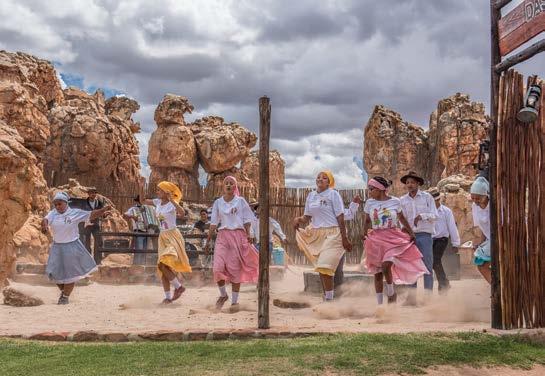
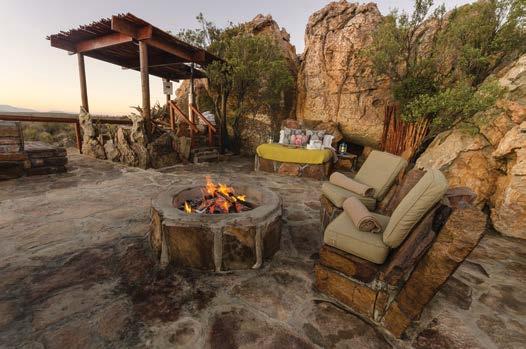



Recently a new ministerial portfolio was created, and the Honourable Minister of Electricity, Dr Kgosientso Ramokgopa, was appointed. But what do we know about him? According to Wikipedia, Kgosientso “Sputla” Ramokgopa is a South African politician who was the Mayor of Tshwane from 2010 to 2016. His academic background includes a Bachelor’s degree in civil engineering, Master’s degrees in public administration and business leadership and a PhD in public affairs. He was born in 1975.
I read in media that Ramokgopa left the City of Tshwane bankrupt after the legal settlement with PEU Capital Partners over a deal to roll out smart electricity meters across the City ended in litigation.
I would like to share a few first-hand details about Ramokgopa’s performance at City of Tshwane. It may give an idea as to how he will tackle his current monumental challenge.
We ran the Sustainability Week conference in partnership with the City of Tshwane from 2011 to 2016, and Ramokgopa was the patron of the event. Among a great many other positive projects and happenings in the green economy that the event’s many sub-sector conferences focused on, we also showcased the work of Tshwane’s City Sustainability Unit under the leadership of Dorah Modise, subsequently influential CEO of Green Building Council SA.
The team under Romokgopa were trailblazers. Aside from many other achievements, they developed the first Green Service Delivery Strategy in South Africa and were mandated to act into all City departments to guide the implementation of interventions aimed at achieving the stated objectives.
Their projects ranged from the first wheeling deal which facilitated the Bio2Watt biogas project in Bronkhorstspruit, making electricity out of various waste streams including sorted municipal solid waste (MSW) and supplying power to the BMW Rosslyn plant and free WiFi to all Tshwane residents, to the first fully-mechanised materials recovery facility (MURF), and the roll-out of smart electricity meters that would enable net metering for small-scale embedded generation.
Ultimately, Ramakgopa was unseated by an ANC opponent before they lost the City to the DA.
Having worked with Ramokgopa, albeit at some distance, I feel optimistic that if anyone in the ANC can pull this mandate through, it is him.
Economy GREEN journal
EDITOR: Alexis Knipe alexis@greeneconomy.media
CO-PUBLISHERS: Gordon Brown gordon@greeneconomy.media
Alexis Knipe alexis@greeneconomy.media
Danielle Solomons danielle@greeneconomy.media
LAYOUT AND DESIGN: CDC Design
OFFICE ADMINISTRATOR: Melanie Taylor
WEB, DIGITAL AND SOCIAL MEDIA: Steven Mokopane
SALES: Gerard Jeffcote
Glenda Kulp
Nadia Maritz
Tanya Duthie
Vania Reyneke
PRINTERS: FA Print
GENERAL ENQUIRIES: info@greeneconomy.media
ADVERTISING ENQUIRIES: alexis@greeneconomy.media
REG NUMBER: 2005/003854/07
VAT NUMBER: 4750243448
PUBLICATION DATE: April 2023
www.greeneconomy.media
Publisher
EDITOR’S NOTE
Africa is blessed with land and resources, enough to supply the whole world, and needs to capitalise on this in a sustainable way. We have sunshine for solar, water for hydro and wind for renewable capacity and an abundance of biomass and waste that can be converted to energy. Chris Whyte, ACEN, points out that the key focus here is energy, and the simple reality is that Africa will never be able to achieve the SDGs without energy. Everything is reliant on energy: we need to avoid the expensive mistakes of before and rather implement viable energy generation (page 18).
The push for renewable energy is showing an increase in solar PV across the country, which in turn drives demand for components and services. Don’t miss our interview with the CEO of SAPVIA (page 24) or our article on wind turbine sourcing (page 30).
Our thought leadership article indicates that despite the speed with which solar and wind power plants could be built, South Africa’s grid itself does not have the capacity to distribute that power (page 44).
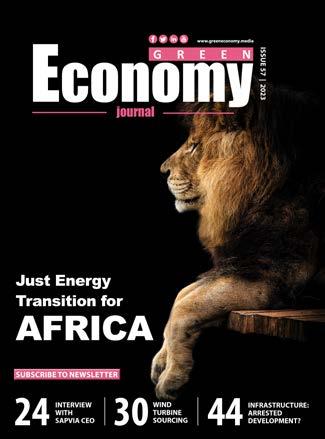 Alexis Knipe Editor
Alexis Knipe Editor
6 All Rights Reserved. No part of this publication may be reproduced or transmitted in any way or in any form without the prior written permission of the Publisher. The opinions expressed herein are not necessarily those of the Publisher or the Editor. All editorial and advertising contributions are accepted on the understanding that the contributor either owns or has obtained all necessary copyrights and permissions. The Publisher does not endorse any claims made in the publication by or on behalf of any organisations or products. Please address any concerns in this regard to the Publisher.
PUBLISHER’S NOTE
THOUGHT [ECO]NOMY


To access the full report in our Thought [ECO]nomy report boxes: Click on the READ REPORT wording or image in the box and you will gain access to the original report. Turn to the page numbers (example below) for key takeouts of the report.

7 Economy GREEN journal 18 30 44 CONTENTS 8 NEWS AND SNIPPETS ENERGY 12 What the world is learning from SA’s energy transition 18 The Just Energy Transition – what it should be ... 24 It’s time for solar to shine: interview with SAPVIA CEO 28 Business Partners urges companies to go solar 30 The future of onshore wind turbine sourcing 34 Wind energy’s leading role in SA’s Energy Action Plan 38 REVOV says that we are morally bound to demand environmentally sound batteries 40 Bringing power back to LiFe: we interview REVOV CEO WASTE 22 NCPC-SA’s waste minimisation programme is improving lives DECARBONISATION 36 Climate impact imperatives by SRK Consulting WOOD PULP AND PAPER 10 PAMSA on the circular economy 42 Forestry: a greener more sustainable future THOUGHT LEADERSHIP 44 Quo vadis infrastructure development 48 DQS Academy: simply leveraging quality READ REPORT
greeneconomy/report recycle key takeouts of the report key takeouts of the report key takeouts of the report 02 01 03
SA WELCOMES CLIMATE CHANGE REPORT
South Africa welcomes the release of the Intergovernmental Panel on Climate Change (IPCC)’s Summary for Policy Makers and a longer synthesis report of the Sixth Assessment Cycle.
“The report brings together the work of leading global scientists over the past six years and clearly shows that more than a century of burning fossil fuels and unsustainable energy and land use worldwide, but in particular in developed countries, has led to global warming of 1.1°C since the start of the industrial revolution,” says the Minister of Forestry, Fisheries and the Environment, Barbara Creecy.
The IPCC finds that with every increment of warming, the risks, impacts, related losses and damages escalate. When these risks combine with other adverse events, such as pollution and loss of biological diversity, they cascade across sectors and regions and become increasingly difficult to manage. Nothing less than an emergency response will suffice.
“It is therefore important, particularly in this decade, to accelerate efforts to adapt to the reality of a rapidly changing climate and to close the existing adaptation gap,” says Minister Creecy.
The scientists tell us that global emissions should already be decreasing and be cut by almost half by 2030. Ultimately, the only way to stabilise warming is to reach net zero CO2 emissions. To limit warming to 1.5°C would require net zero CO2 in the early 2050s, followed by net negative CO2 emissions in the decades thereafter.
“Through the Just Energy Transition Investment Plan (JET-IP) we have identified measures in the electricity, transport and hydrogen sectors and value chains to contribute to decarbonisation of our economy. It is not just an energy transition plan, but a just one –and this puts workers and communities at the centre of defining their future in a low carbon economy. The JETP-IP will require over R1.5-trillion to be fully implemented. We have challenged our partners and multilateral development banks to increase finance for climate investments. This is important to achieve global climate goals and our view is that there is sufficient global capital to close the gaps.”
The IPCC indicates that these finance gaps and opportunities are greatest in developing economies. A rapid scaling up of finance flows from global capital markets and supporting public funding from developed economies for enhanced mitigation and accelerated adaptation, can act as a catalyst for accelerating the global shift to sustainable development.
More importantly, the IPCC indicates that grant-based public financing is crucial to accelerate adaptation activity, which is severely underfunded. The greatest gains in wellbeing can be achieved by prioritising finance to reduce climate risk for the most vulnerable regions (especially in Sub-Saharan Africa), and for the most vulnerable, low-income and marginalised communities.
Mitigation faces a different challenge: leveraging private finance through public financing by reducing some of the risks inherent in upscaling mitigation, especially in newer sectors, and in developing regions, including those facing debt and public financing macroeconomic constraints. The JET-IP needs to support social justice, including in financial terms.
JET MUST CONSIDER AFRICA’S NEEDS
Africa must be given the space to transition from high carbon usage to low carbon at a pace and cost that it can afford, says Minister of Mineral Resources and Energy Gwede Mantashe.
“Their voice [African people] on the energy transition must be heard. That is the voice that says, energy production in Africa must be aligned to Africa’s socio-economic development. This means that there must be a balance between energy demand for socio-economic development and energy supply that is premised on low carbon emissions,” he says.
Africa’s mineral resources

Mantashe says the continent’s rich endowment with minerals that are suitable for clean energy production could mean a boost for the continent’s economies. “We believe that it is in the interest of Africa that a rigorous mineral exploration programme is implemented to uncover these unknown deposits in many other countries of our continent. For its part, South Africa continues to mobilise investments in exploration informed by the understanding that it is the lifeblood of mining, which has been the backbone of our economic development for over 150 years.”
NEW CEO FOR PRO ALLIANCE

The Paper and Packaging PRO Alliance has announced the appointment of Dorah Modise as its new chief executive officer, effective from 1 April 2023. Modise’s personal philosophy, backed by considerable experience, is fully attuned to her new set of responsibilities.
“I look forward to working with alliance partners in leading this great organisation that will demonstrate the power of collective action in a dynamic sector that is largely untapped. Waste is the new gold and with industry taking the lead on massifying recycling, recovery, beneficiation and market enhancement programmes, we will take several steps towards achieving sustainability,” she says.
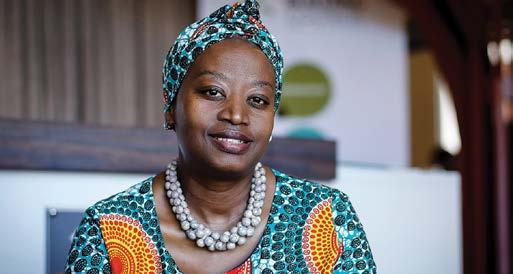
8
NEWS & SNIPPETS
Minister Creecy.
WOLF WIND BREEZES CLOSER TO NATIONAL GRID
An 84MW Wolf Wind project in the Eastern Cape has reached financial close and is projected to start generating electricity for the national grid by the first quarter of 2024.
Juwi Renewable Energies reports that exploding public and private demand for large-scale renewables because of South Africa’s energy crisis has led to the rapid expansion of its national footprint, with more than 1.5GW of wind, 2GW of solar and 500MW of hybrid projects incorporating storage in development for private and public energy users.
The Wolf Wind project was successfully bid by Red Rocket in Round 5 of the government’s Renewable Energy Independent Power Producers Procurement Programme (REI4P). Wolf Wind is the second wind project developed by Juwi to reach financial close under the REI4P – the first being the 138MW Garob Wind Project, which reached commercial operation in 2021. The Wolf Wind Project is expected to generate more than 360GWh of clean electricity for the South African grid each year, offsetting 374 400 tons of CO 2 each year.
Positive economic contribution
Wind has significantly demonstrated its positive economic contribution with a total procurement by wind IPPs during construction and operations to date exceeding R9-billion in value.
SAWEA’s chief communications officer, Morongoa Ramaboa, says the Association welcomes the government’s approach to accelerate private investment in generation capacity, through the removal of the licensing requirement for generation projects of any size, the
RECYCLABLE WIND TURBINE BLADES
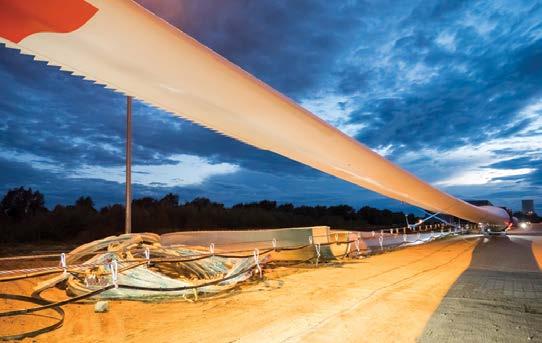

Nordex Group is participating as one of the 18 partners, in a sustainability project funded by the European Union, to drive the recycling of high-value rotor blade materials from wind turbine blades.
Currently, 85% to 95% of a Nordex wind turbine is recyclable. For many of the materials used, there are established recycling processes for environmentally-friendly disposal – especially for steel and concrete, which make up the largest share of a wind turbine in the tower and foundation.
Turbine rotor blades consist of a combination of different materials such as wood, various metals, adhesives, paints and composites. The composites are glass-fibre-reinforced plastics, as well as carbonfibre-reinforced plastics. At the end of their life, rotor blades are more challenging to recycle due to the heterogeneity of the material and the strong adhesion between the fibres and polymers. Recycling processes for these materials are not yet fully established, and reuse of recycled materials is not widespread.
reduction of timeframes for regulatory approvals, as well as the establishment of a “one-stop shop” for energy projects through Invest SA.
“The ideal is to create an environment that encourages and accelerates investment injection into the economy, removing the pressure from public fiscus, and to stimulate the private sector to invest in their own energy supply and create new industries,” she says.
Niveshen Govender, SAWEA CEO, says a clearly defined queueing system needs to be urgently implemented with a balanced view between publicly and privately procured electricity.
“Ministerial determination for over 18 000MW of new generation capacity from wind, solar and battery storage should be prioritised since it was published in August last year,” he says, noting that the intention to enable businesses and households to invest in rooftop solar is a good start towards addressing the country’s energy crisis. This requires the development of a net billing framework for municipalities to enable customers to feed electricity from rooftop solar installations into the grid.
“To realise our vision of becoming a thriving commercial wind power industry that supports government in its mandate to secure energy for South Africa, we cannot afford a repeat of the latest failed public procurement bid window (BW6), which has resulted in the loss of investment and market confidence.
“The current system for allocating grid access remains a pressure point as it marginalises capable and willing organisations that can contribute significantly to the supply of electricity,” Govender says.
By Neesa Moodley. Courtesy Daily Maverick.
“In line with our group’s Sustainability Strategy 2025, ambitious goals have been set, including offering the market a fully recyclable blade within the next decade, with the target set for 2032,” explained Nordex MD, Compton Saunders.
To reach this goal, Nordex have conducted and participated in several Research and Development projects, one of which is the European-funded “Wind turbine blades End of Life through Open HUBs for circular materials in sustainable business models”, or EoLO-HUBS for short.
The objective of the EoLO-HUBS project is to demonstrate and validate a set of innovative composite material recycling technologies which will provide answers to the three main areas involved in endof-life wind farm recycling: de-commissioning and pre-treatment of wind turbine blades; sustainable fibre reclamation processes addressing two alternative routes: low-carbon pyrolysis and green chemistry solvolysis; upgrading processes for the recovered fibres addressing mainly glass fibres as well as carbon fibres.
9 NEWS & SNIPPETS








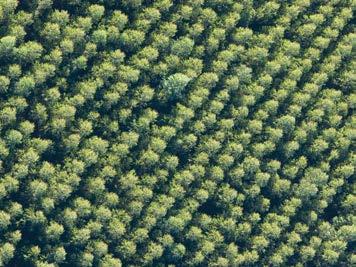

What the world is learning from SA’s nascent
What the world is learning from SA’s nascent JUST ENERGY TRANSITION INVESTMENT PLAN



Ramaphosa has been praised by global leaders for South Africa’s efforts to prevent and avert the worst effects of human-induced climate change as part of its Just Energy Transition Investment Plan.
BY ETHAN VAN DIEMEN
South Africa’s Just Energy Transition Investment Plan (JET-IP) is designed to accelerate the move away from coal in a way that protects vulnerable workers and communities and develop new economic opportunities such as green hydrogen and electric vehicles (EVs). It is part of South Africa’s efforts to prevent and avert the worst effects of human-induced climate change.
UK Prime Minister Rishi Sunak, US President Joe Biden, French President Emmanuel Macron and German Chancellor Olaf Scholz have commended South Africa for its commitment to clean energy but importantly the country’s emphasis on assisting workers and communities who will be affected by job losses as we become less reliant on the coal industry.

12
ENERGY
Earthlife Africa director Makoma Lekalakala welcomed the five-year R1.5-trillion investment plan, summing up why our JET-IP is a gamechanger for South Africans. “We need clean, cheap renewable energy to end the loadshedding caused by our failing coal fleet, and to address the energy poverty that is hampering social justice and development for all.”
South Africa is among the top 20 highest emitters of planet-warming greenhouse gases in the world and accounts for nearly a third of all of Africa’s emissions, due in large part to Eskom’s legacy dependence on coal for electricity generation. From the way we move people and goods around to how we light up our streets and homes, the plan seeks to clean up South Africa’s act without leaving anyone behind.
Mandy Rambharos, former general manager of the Just Energy Transition office at Eskom said several banks, including the World Bank and African Development Bank, said South Africa’s plan is the best they had seen on the table out of 14 plans from around the world. “While I was at Eskom, we were approached by the Vietnamese, Indonesians, Philippines and Indians ... wanting to collaborate with us.”
One of the reasons that South Africa is recognised as a leader in its moves towards JET is because of the multistakeholder consultative process that saw the drafting of a Just Transition Framework.
The Presidential Climate Commission (PCC) in July last year released
the framework that sets out a shared vision for JET, principles to guide the transition, and policies and governance arrangements to give effect to the transition from an economy that is predominantly reliant on fossil fuel-based energy, towards a low-emissions and climateresilient economy. Dr Crispian Olver, executive director of PCC, said that “a lot of the international partners … are looking to build a model [such as] in South Africa, and then expand it and replicate it elsewhere.
“We’ve also heard the same from many of our sister developing countries and they’re not looking to exactly replicate what we’re doing … but we’re acutely aware that countries like Indonesia, Vietnam, India, Brazil and several African partners are all embarking on very similar energy transitions and they’re having to grapple with the economic and social consequences of those transitions”.

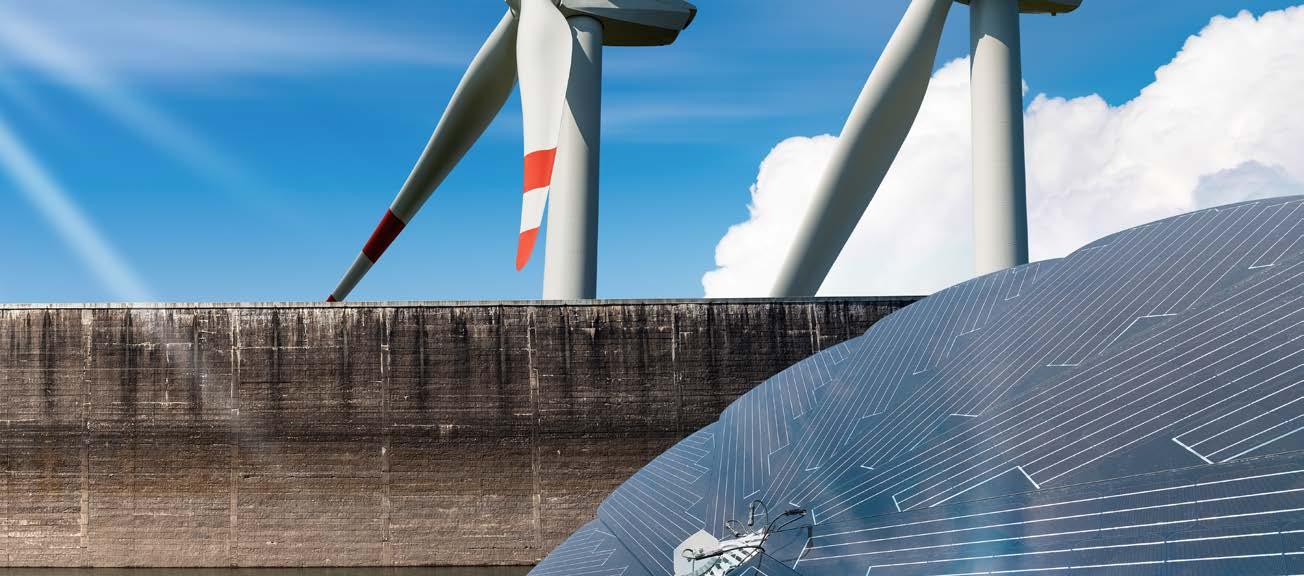
Olver shared some of the lessons that South Africa offers to other countries. These include to:
• Be consultative
• Be inclusive
• Make use of forums such as climate commissions
At COP26, in what was hailed as a “watershed” moment for South Africa and international collaboration, a political declaration announced the mobilisation of $8.5-billion to accelerate our move away from its ageing,

13
ENERGY
polluting and unreliable coal fleet towards renewable energy sources. The declaration heralded the first step in developing a pioneering model for climate-focused partnerships and collaborations between developed and developing countries.



United Nations (UN) Secretary-General António Guterres, at the conclusion of the conference said, “To help lower emissions in many other emerging economies, we need to build coalitions of support including developed countries, financial institutions and those with the technical know-how. This is crucial to help each of those emerging countries speed the transition from coal and accelerate the greening of their economies.
“The partnership with South Africa announced a few days ago is a model for doing just that,” the UN chief added.
The model was formed after the governments of South Africa, France, Germany, UK, US and the European Union – collectively known as the International Partners Group (IPG) – signed the political declaration. The coalition of rich countries and South Africa came to be known as the Just Energy Transition Partnership (JETP) and spurred the development of both the investment plan as well as a framework for how best to move away from coal in a way that doesn’t leave workers along the coal value chain – particularly in Mpumalanga – stranded and destitute.
Plans and pledges became reality when South Africa signed separate, highly concessional loan agreements with the French and German public development banks, AFD and KfW, worth €600-million (R10.7-billion). France and Germany are two of the partners in South Africa’s JETP, along with the US, the UK and the European Union. With associated interest rates for loans agreed at 3.6% and 3%, respectively, the loans are more palatable than the 8.9% the government would expect to raise an equivalent loan today in the open market.
Amar Bhattacharya, a senior fellow in the Centre for Sustainable Development, housed in the Global Economy and Development programme at Brookings Institution, described our investment
PIPELINE OF PROJECTS
Fumani Mthembi from Knowledge points out that what is needed is increased investment in improving capacity and competence amongst policymakers, investors and project developers. In addition, the development of specialised vehicles for project incubation and aggregation; working with existing project portfolios to effect change; reforming financial institution and financial sector incentive structures, reporting, benchmarks and project valuation frameworks and improving flexibility of public sector financing frameworks.
Mthembi explains that the potential to upscale community projects was hampered by several factors including regulatory challenges. She explains that “just transition projects, by their nature, introduce technologies and ways of generating value that are novel, to the extent that decarbonisation has not historically been central to the impetus of job creation. Consequently, they often run into regulatory challenges, requiring changes to be made to enable project viability.”
She says that “funding typically supports the operational aspects of project rollouts but the demand on developers to advance the more systemic changes required to enable scale is not incorporated into the funding package, placing added burden on project developers. Regulatory change is, therefore, often the product of the unpaid labour of developers who stretch and strain themselves to generate the public good that is an enabling regulatory environment.”
Other issues include the need for public-private partnerships; the need to factor in the broader political context of implementing such projects especially at a community level and time is a key factor in developing community projects for scale. Finally, there is the issue of gender when it comes to small-scale projects and how so-called “women’s work” often is under-remunerated.
14
ENERGY
To help lower emissions in many other emerging economies, we need to build coalitions of support including developed countries, financial institutions and those with the technical know-how.
plan as “precisely the kind of model that is needed to lay out an actionable plan. It has got justice running through it … I want to emphasise something … this is a sustained effort, five years to start with is good but it will require a generational shift.”
Lebogang Mulaisi, head of policy at COSATU, was lukewarm about the JETP and the investment plan that came of it. “It’s a start for a broader conversation around how to finance the transition … I’m not convinced, as yet … that we go deep into how we’re going to address ownership structures in South Africa.”
She said reskilling and upskilling is great, “but we have an ownership crisis in our country … and I just don’t feel we’ve addressed the issue of addressing inequality decisively”.
Indonesia and India are two developing countries with similar coal dependencies and are at different stages of their transitions.
Dr Sandeep Pai is a senior research lead with the Global Just Transition Network at the Centre for Strategic and International Studies (CSIS). His expertise spans the political economy of energy transitions, coal sector dynamics, energy access and just transitions.
“Indonesia is very interested in multilateral financing to phase out coal in the long term. India, not so much. India considers coal as a key energy security source. Generally, India is not interested in any deals that focus on coal phase-out or phase-down. However, both countries are in JETP negotiations with G7 countries. G7 and Indonesian negotiations are at advanced stages but negotiations with India are going slow,” he said.
Asked whether South Africa’s JETP can be considered a model, Pai said “Yes, JETP partnerships theoretically could be a model for catalysing a coal phase down in India and even Indonesia. However, not the way it has played out in South Africa. India and Indonesia need to learn many lessons from South Africa’s JETP model. India and Indonesia need to come up with investment plans … do their homework, identify projects they want to execute, and then negotiate JETPs with rich countries … I don’t think either of these countries has done their homework yet.
“[The] South African JETP model – although very relevant for India and Indonesia – won’t be meaningful for workers and the climate in its current form.
“India and Indonesia have a lot to learn from South Africa about how to run and engage a variety of stakeholders, including unions, regions and municipalities in Mpumalanga, to very concrete technical issues such as how to repurpose coal plants being undertaken by Eskom.”
Dr Rahul Tongia, a senior fellow with the Centre for Social and Economic Progress in New Delhi, largely concurred with Pai. He is also a non-resident senior fellow in the Energy Security and Climate Initiative at the Brookings Institution. He explained that while lessons can be drawn from the South African experience, the country’s JETP is more accurately described as a “reference point” for India and other countries with heavy coal dependencies. “South Africa is heavily coal dependent, more so for its power sector, but there are critical differences with, say, India, that make South Africa’s JETP more useful as a reference point than as a template. Most South African coal power plants are multiple decades old, and thus close to end of life. “In contrast, the median age of India’s fleet is close to just over a decade old.”
Sinthya Roesly is director of finance and risk management at Perusahaan Listrik Negara (PLN) – an Indonesian state-owned electricity distribution monopoly which supplies most of the coalfired power to the country. PLN, for all intents and purposes, can be considered the Indonesian Eskom. She acknowledged that while there were lessons to be learnt from South Africa’s experience, Indonesia needs to “look into every aspect of the transition” and that it is important to be “cautious in early retirement [of coal power plants]… balancing all energy sources to support the economy”.
Roesly’s sentiments accorded with those of Gwede Mantashe, Minister of Mineral Resources and Energy, who in a parliamentary debate on JET said, “Our transition cannot only be about reaching climate change targets. It must also address energy poverty, which includes lack of access to energy, unaffordability of energy and electricity interruptions or loadshedding. A pendulum swing from coal-powered energy generation to renewable energy does not guarantee baseload stability. It will sink the country into a baseload crisis.”
Amos Wemanya, the senior renewable energy and just transition
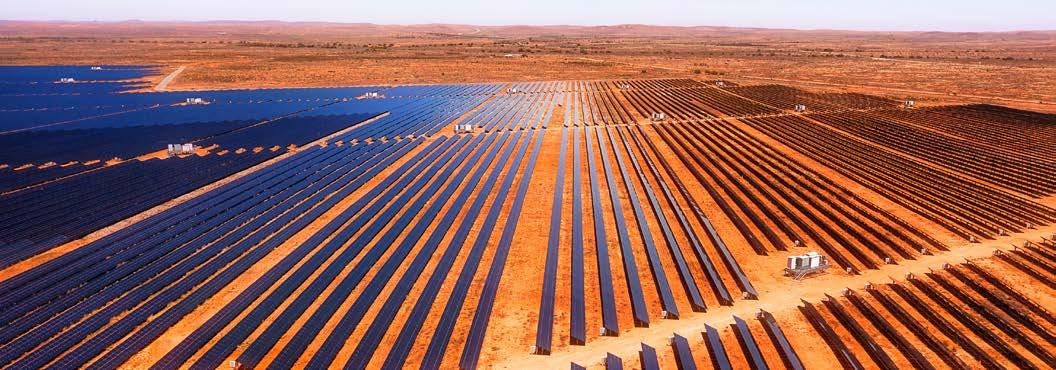
JET-IP, SET, GO
JET-IP identifies USD98-billion in financial requirements over the next five years to come from both public and private sectors. The JET-IP goal is to decarbonise our economy to within the NDC target range of 350-420MtCO2 by 2030 in a just manner. JET-IP is centred on decarbonisation, social justice, economic growth and inclusivity as well as governance. The investment criteria for the Plan include projects that deliver on greenhouse gas emissions reduction and JET outcomes and are catalytic in nature and ready to implement. Key investments include:
• Electricity. Decommissioning (repowering and repurposing with clean technologies), transmitter grid strengthening and expansion, and renewable energy.
• New Energy Vehicles. Decarbonising the automotive sector and supporting supply chain transition towards green manufacturing.
• Gaseous Hydrogen. Essential planning and feasibilities including port investment to enhance exports and boost employment and GDP.
• Cross-cutting. Investment in skills development and municipalities.

15 ENERGY
Article courtesy Daily
Maverick
ENERGY
JET POLICY DEVELOPMENTS
The National Development Plan (NDP), draft Integrated Energy Plan (IEP), Renewable Energy White Paper, Nationally Determined Contribution (NDC), Just Transition Framework and enabling policies under development and in implementation, outline the policy foundation for energy transition in South Africa and the move away from carbon-fuelled energy.
The Integrated Resource Plan (IRP) 2019 covers the government’s plans for power until 2030 and outlines a decreased reliance on coal-powered energy and an increased focus on a diversified energy mix that includes renewable energy, distributed generation and battery storage.
The Renewable Energy Independent Power Producer Procurement Programme (REIPPPP), introduced in 2011, outlined the procurement of renewable energy in the country. The sixth round of the REIPPP kicked off in 2022 and aims to procure 2.6GW of solar and wind power.
To incentivise the self-generation of renewable energy, the government has indicated that it proposes to scrap the threshold for distributed energy generation of 100MW.
Other developments include, inter alia, the South African Automotive Masterplan, Climate Change Bill, Green Taxonomy and carbon tax increases. Further policies such as the National Energy Efficiency Strategy and Green Transport Strategy also have a role to play.
Trading in carbon offsets in the carbon market, where companies can pay other entities to offset their emissions for them, is also growing in popularity in emerging markets. In August 2022, the JSE announced that it was investigating the possibility of introducing a carbon trading market in South Africa.

In February 2022, the South African Hydrogen Society Roadmap was published by government. The roadmap is an important marker on its path towards implementing hydrogen development.
Eskom identified 18 IPP bids in terms of an auction relating to the use of vacant land it owned in Mpumalanga situated in proximity to its coal-fired power stations with direct access to the national transmission network that will enable wheeling. The projects will add almost 1 800MW of renewable power to the grid.
Recent amendments to the Electricity Regulation Act were proposed by DMRE and are likely to address the electricity supply deficit, vertical structure of the market and lack of competition, introduction of a multi-market including IPPs as well as the formation of a central purchasing agency. The amendments will address the introduction of a day-ahead market to accommodate hourly supply and demand, direct procurement of power by municipalities, increase in the threshold pertaining to self-generation, need to accommodate low carbonemitting generation technologies, timing of licensing applications, changes in transmission system operation including power trading and the creation of additional regulatory capability. The aim is to accelerate affordable, decentralised, diversely-owned renewable energy systems.
THOUGHT [ECO]NOMY

adviser at Power Shift Africa, a Pan-African think-tank, called for caution. He said, “If done right, JETPs could offer an opportunity for piloting transformative approaches to addressing aspects of the energy transitions – like early coal retirement – in a principled way. They can also potentially help aspiring oil and gas producers such as Senegal choose climate-friendly development pathways.
“However,” Wemanya added, “JETPs could also perpetuate the continuation of a troubling donor-driven approach to climate finance that maintains unequal global power relations, picks winners and losers, and serves geopolitical interests. JETPs must be considered within the wider climate finance architecture and as a mechanism to put more and faster climate finance on the table, particularly from major historical polluters.
“It is also important to recognise that ambitious goals such as achieving just energy transitions in Africa will require solutions that lie well outside the boundaries of JETPs.”
JET-IP SETTER
Discussing her research which focused on just transition project needs and finance response, Chantal Naidoo from Rabia Transitions says, “Projects are the primary channel where finance is exchanged in pursuit of the just transition vision.” She adds, “The distinguishing features of just transition projects are their focus on regenerative and transformative outcomes to people and planet due to deliberate shifts in systemic conditions and factors outside
SOUTH AFRICA’S JUST ENERGY TRANSITION INVESTMENT PLAN (JET IP) FOR THE INITIAL PERIOD 2023-2027 | The Presidency Republic of South Africa | NDP 2030
The JET-IP focus on electricity, new energy vehicles and green hydrogen (GH2) is a deliberate strategic decision, based on a clear understanding that as South Africa’s electricity sector decarbonises, there are significant gains to be made by unlocking growth in these sectors at the same time.
South Africa’s exports from “hard to abate” sectors and of ICE vehicles will be negatively affected by the proposed border tax adjustments of some of the country’s main trading partners, if accelerated mitigation measures in these sectors are not implemented. As the energy transition advances globally:
- More complex linkages between sectors will develop, as zero-carbon electricity use replaces the use of fossil fuels in industry, transport and other sectors, and thus the benefits of an integrated energy policy approach, which incorporates energy policy closely with other key policy areas such as industrial policy are significant.
- Technologies will become progressively cheaper through economies of scale and where policies mitigate investment risks and/or technological breakthroughs. When they pass below the cost levels at which such technologies become pervasive, the technologies are described as “disruptive” and are said to have passed “tipping points”. Sector coupling means that tipping points in different technologies reinforce each other.
- Clean energy investments scale up most rapidly when they experience certainty about demand for their production. Security of demand mitigates investment risk.
- Investments in existing storage technologies such as pumped storage; emerging technologies which include utility-scale batteries at all scales; thermal storage in concentrating solar power (CSP) plants and elsewhere; and other potential technologies such as GH2 will enable faster uptake of renewable electricity generation in electricity systems and will become more and more important as the electricity system is decarbonised.
16
READ REPORT
report recycle
greeneconomy/
AfricaBusiness.com
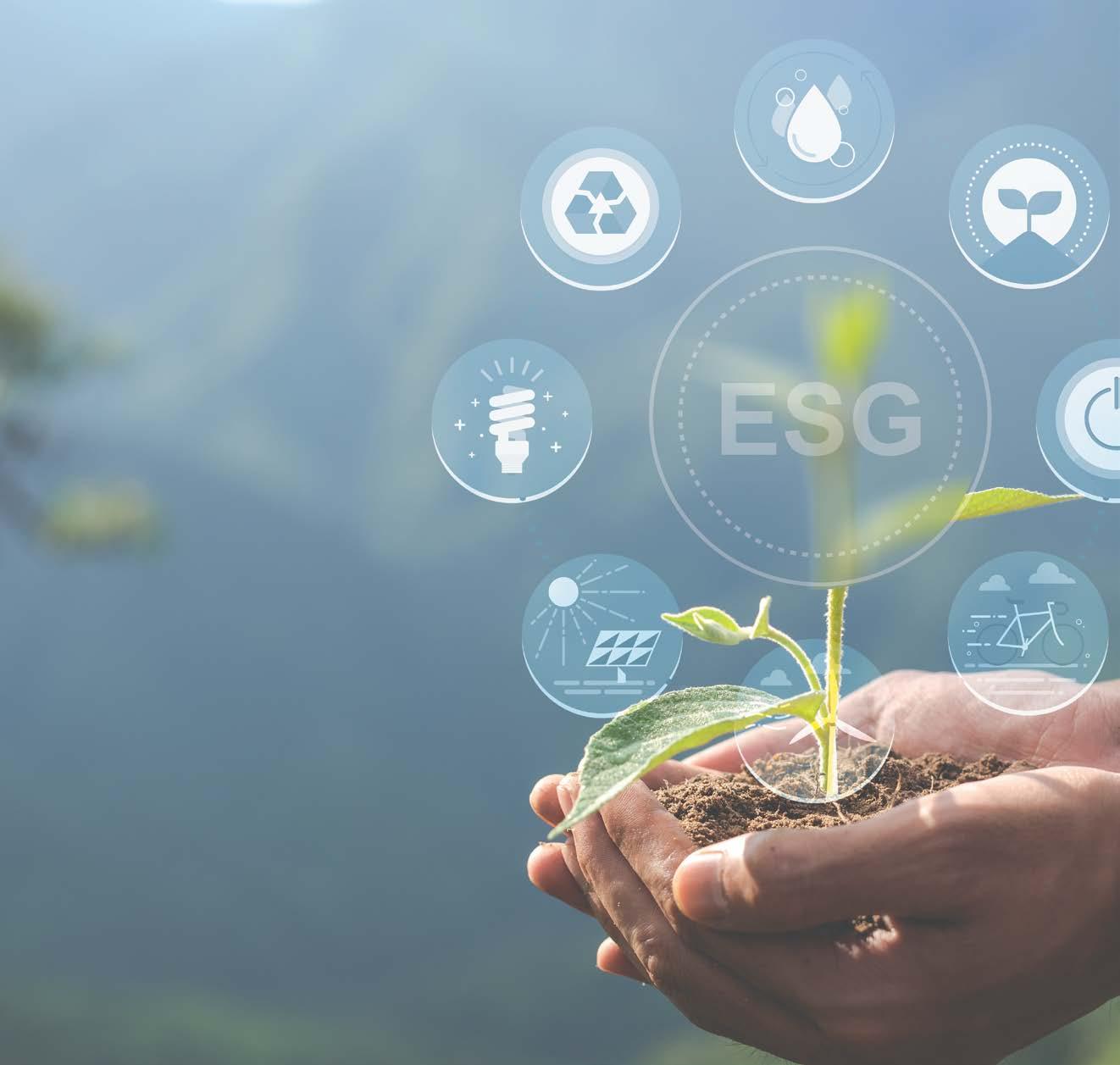

ESG | MINING WATER | ENERGY INFRASTRUCTURE
THE JUST ENERGY TRANSITION – what it should be…

There has been a lot of press recently regarding the Just Energy Transition Partnership in South Africa with links to international funds to facilitate this transition – but what exactly is a “just” energy transition? First, we need to contextualise the problem and understand the solutions.
BY CHRIS WHYTE, ACEN*
Africa currently has a population of about 1.34-billion people, and this is expected to rise to almost 2.5-billion by 2050. Globally, there is a focus on understanding this dynamic regarding sustainability, and climate change is a key component of this focus. World leaders urge sustainability and achievement of the UN Sustainability Development Goals (SDGs). This vision and reality are somewhat different for Africa. Africa currently faces massive unemployment and poverty with its existing population. Some 650-million people on the continent currently have no access to electricity.

The key focus here is energy, and the simple reality is that Africa will never be able to achieve the SDGs without energy. Everything is reliant on energy: access to reticulated water, agriculture, foodsecurity, agri-processing, manufacturing, transport, infrastructure, tourism, mining, education, health and just about any other sector you can name.
To put into perspective, Africa relies on around 700 000GWh electrical
consumption capacity. South Africa, as one of 54 countries on the continent, supplies more than 30% of this. In 2018/19, South Africa sold 208 319GWH of electricity for consumption which made up close to 30% of the estimated 700 000GWh of electricity used in Africa in 2018. To put this into a global perspective, South Korea generated 530 000GWh at 0.33% the area of Africa and only 3.4% of Africa’s population. The size of Africa is often underestimated because of traditional Mercator projections on maps – the reality is that we can fit all of Europe, USA, China and India into Africa with space for many other countries. Africa is blessed with land and resources, enough to supply the whole world, and needs to capitalise on this but must follow a sustainable path. We have sunshine for solar, water for hydro and wind for renewable capacity and an abundance of biomass and waste that can be converted to energy.
What we need to do as a continent, is avoid the expensive and unsustainable mistakes of the developed North and rather implement scaled, sustainable and viable energy generation. Transmission in
18 ENERGY
traditional high-voltage lines is inefficient and the massive distances needed to transmit power across the vast mass of Africa simply does not make sense.

The intense capital required for this also excludes normal people from benefitting from this abundance, so governments and global corporates control energy and drive the equality gap even further.
The Gini index is a measure of the distribution of income across a population, and South Africa had the highest inequality in income distribution globally in 2021 with a Gini score of 63. This can be changed, and all the technology and applications are available to do this to ensure a just transition to energy access.

The focus needs to be changed to small-scale systems tied into microgrids, where ordinary citizens can benefit from cheaper and more reliable electricity, but importantly also be direct beneficiaries of this (Power to the People!). Renewable and sustainable energy can be scaled from the household to the village to the city:
• Scaled applications in solar energy can change the dynamic in Africa, reducing the reliance on poor service delivery from the public sector.
• Hydropower can be delivered at microturbine level from as small as 1kW output without the need for billion-dollar hydroelectric schemes that displace communities, create cross-border conflict and destroy biodiversity and riverine ecology.

• Vertical and horizontal wind turbines can work at the household or community level.
• Waste organics can be scaled to provide gas or electricity.
• Biomass can be grown or harvested to supply small-scale gasifiers, avoiding the need for deforestation and charcoal production.
• The East African Rift Valley provides massive potential for clean geothermal energy, untapped to date.

• Waste plastics (where there is no local circular market for recycling) can be converted to fuel for generators or gasified directly into electricity.
• Water can be reticulated for household or irrigation use using ram-pumps that need no electricity.
19 ENERGY
Africa is blessed with land and resources, enough to supply the whole world.
There literally is no need for massive hydro investments or fossil fuel extraction that impact the land and the air and destroy biodiversity and ecosystems. In South Africa, the biggest polluter by some margin is our own debt-ridden Eskom. The Mpumalanga Highveld region has 12 coal-fired power stations, which have gained a reputation as being the most toxic and polluting group in the world.
South Africa is the 12th biggest emitter of sulphur, Nitrogen and carbon dioxide in the world. Most of this comes from our 80% energy dependence on coal and the US$8.94-billion concessional funding pledged to us at CoP26 in Glasgow is intended to wean us off this dependence. Not because we are a good investment destination, but rather because we are globally recognised for literally killing thousands of our own citizens every year from respiratory illnesses considering the above rankings.

A just transition is not just about equitable economic distribution. It is also about environmental and social justice to achieve a healthy and safe South Africa for all our citizens. The remainder of Africa still needs to attain energy independence, and it is essential that we follow a just transition approach across the continent.





20
ENERGY
*African Circular Economy Network (ACEN)
The focus needs to be changed to small-scale systems tied into microgrids, where ordinary citizens can benefit from cheaper and more reliable electricity.




• Long term sustainability through resource savings

• Economic growth
• Environmental compliance
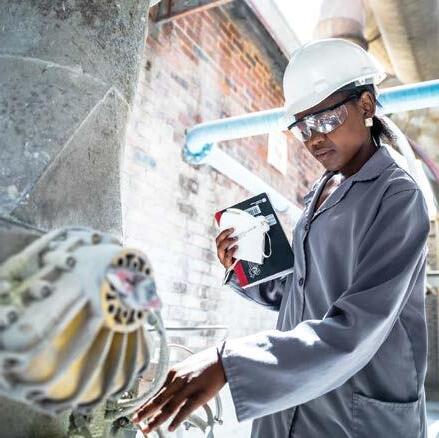
• Contributes to social development
Services include:
Green skills development
Industry and sector knowledge sharing
Company technical support
Funded by the dtic, hosted by the CSIR
Invest in Industrial Efficiency
National Cleaner Production Centre
A national industrial support programme that partners with industry to drive the transition towards a green economy and save money. Contact us for a free assessment www.ncpc.co.za ncpc@csir.co.za THA 05-2023
South Africa
Waste minimisation programme IMPROVING LIVELIHOODS in Limpopo
Waste management, inadequate diversion and the depletion of landfill space remains a challenge in South Africa. However, there are opportunities to not only alleviate the waste but also create jobs and positively impact livelihoods.
BY NCPC-SA
Arecent event hosted by the Limpopo Department of Economic Development, Environment and Tourism in collaboration with the National Cleaner Production Centre of South Africa (NCPC-SA) highlighted the impact made through a waste minimisation programme in the province over the past three years.

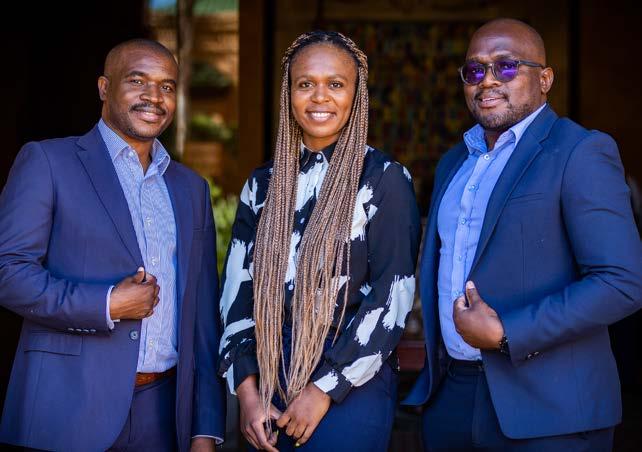
Since taking off in 2019, the Industrial Symbiosis Programme or ISP as it is more commonly known has successfully diverted 49 518 tons of waste from landfills, saving 181 370 tons in CO2 emissions and unlocked economic opportunities in the province.
National programme manager, Victor Manavhela, says, “This event is evidence that we can transition to a waste-free society and use waste as a resource to change lives. We are looking to replicate this work in all the provinces in the next few years.”
The ISP, facilitated by the NCPC-SA, has been a successful partnership project in many provinces that aims to reduce waste to landfills and encourage waste circularity or resource exchanges.
NATIONAL PROGRAMME, LOCAL IMPACT
A year after establishing the industrial symbiosis partnership, Dziphathutshedzo Green Surfacing and PWK Waste Management Recycling has already diverted 11 tons of waste from the landfill. Dziphathutshedzo Green Surfacing recycled HDPE plastic that was collected and stockpiled by PWK Waste Management and manufactured it into eco-friendly and durable paving bricks and stepping stones.
This is just one of the 40 IS success stories that were celebrated at the Limpopo ISP impact and information-sharing workshop. The
workshops demonstrated how Limpopo ISP assisted industry in the surrounding area to recover and redirect residual resources for reuse by employing IS principles.
The ISP is a free facilitation service that promotes the exchange of one company’s residual resources (material, energy, water, waste, assets, logistics and expertise, etc) with another that can benefit from them.
Including Limpopo, the NCPC-SA implements the ISP in Gauteng, KwaZulu-Natal, Mpumalanga and the Free State. The NCPC-SA is a national industry support programme managed by the Council for Scientific and Industrial Research on behalf of the Department of Trade, Industry and Competition.
To find out more about the ISP and/or the work of the NCPC-SA, please visit www.ncpc.co.za or email ncpc@csir.co.za
23 WASTE
Victor Manavhela, NCPC-SA national programme manager at Limpopo ISP.
The NCPC-SA team: Victor Manavhela, Annah Mothapo and Matimba Makhani.
We can transition to a waste-free society and use waste as a resource to change lives.
It’s time for SOLAR TO SHINE
Green Economy Journal interviews the CEO of SAPVIA
SAPVIA CEO, Dr Rethabile Melamu, believes that the wide deployment of solar PV and broader renewable energy technologies can support a resilient energy system in South Africa. Will the tax relief programme anchor our green economy transition? The Journal caught up with Dr Melamu, the illustrious leader at the coalface of it all.

Please tell us about your first year as CEO of SAPVIA. It has been an incredible year. A year of immense growth, stretching and learning. I inherited a good and a growing brand, with a lean but supportive team and the Board. Leading a member-led organisation is unique and it is like nothing I’ve done before. It is rewarding to be of service, but is it not without its unique demands of attending to the vastly different needs of 500+ members.
I hope to continue to meet and to add value to all members. This year has been challenging for all South Africans, but together with our members, we are providing an alternative and immensely sustainable solution to the loadshedding and energy security challenges. Overall, it is a privilege to work with and alongside those that are providing solutions to the most pressing challenges.
Does government consult with SAPVIA for matters relating to the development, regulation and promotion of solar PV in South Africa?
Most definitely, we have had good engagements with different spheres of government, from national, provincial and to the local level. For instance, we have supported the Department of Mineral Resources and Energy (DMRE) as well as the Department of Trade, Industry and Competition (the dtic) in the development of the South African Renewable Energy Masterplan (SAREM).
We have contributed to Eskom’s grid planning and access processes in partnership with our sister association, South African Wind Energy Association (SAWEA) and we enjoy a great relationship with the Independent Power Producers Office (IPPO).
That said, we have called on the powers that be for more involvement in the decision-making that involves our sector and members. For instance, we would have valued engagement in the design of tax incentives for the solar PV sector. We have views on areas that needed to be prioritised.
Please talk to us about policy certainty in this space.
There is generally a commitment to the transition towards a lowcarbon energy mix. This is evident in government’s recent regulatory reforms that removed the need for independent power producers who develop private projects to hold a generation licence, which has been touted a good move. This aims to speed up the addition of new generation capacity to the grid. The results are beginning to show, with 0.5 GW of utility scale projects registered with the National Energy Regulator of South Africa (NERSA) in the first months of 2023.
The Integrated Resource Plan is being updated to comprehensively address the current change and long-term planning. However, there is more to be done to effectively enable the roll-out of embedded
24 ENERGY
generation projects and the development of grid infrastructure to enable uptake of new generation capacity, in particular renewable energy projects. That requires for Eskom and municipalities to create rules, regulations and tariffs. A clearer articulation of Just Energy Transition action as well as the envisaged role of the industry is needed. A nationwide wheeling framework for private projects will further enable ease of project developments.
How will a rapid growth in solar installations affect the market?



SAPVIA estimates that the installed solar PV capacity exceeded 1 GW for the first time in 2022. We have seen substantial growth in private projects registered with NERSA and not signed up. We are expecting sustained growth, especially in the private sector where investment in utility scale renewable energy projects both for direct consumption, i.e. behind the meter or embedded generation, and for wheeling, where generation and consumption are at two different sites.
Dr Melamu, do you have any reservations about the rooftop solar PV tax incentives? If so, what are your concerns?
The individual tax incentive has prioritised middle to high-income households who already have access to capital to invest in solar PV systems. This completely leaves out low-income households, who are not able to access instruments availed by financial institutions and other industry players. The fact that incentives cover modules alone while most households install hybrid systems (PV, inverter and battery system) is a surprise. The administrative requirements for accessing the tax incentive are confusing – mainly that only a certificate of compliance is required for accessing the incentive, which covers the part of the system that is not incentivised.
SAPVIA has indicated that the waiting period for the installation of solar PV is increasing. Why is this?
There is a shortage of skilled installers with adequate experience and training. Those reputable installers tend to be inundated. As such, SAPVIA is working with various partners such as the Energy and Water Sector Education Training Authority (EWSETA), the Small Enterprise Finance Agency (SEFA) and the Small Enterprise Development Agency (SEDA) to increase the pool of installers.
Please talk to us about the importance of economies of scales and predictable demand for facilitating investments needed for the manufacture of solar PV installation components. This is mainly driven by increased demand for PV components, exacerbated by the frequent episodes of loadshedding. First, there needs to be an understanding of localisation potential, that’s why SAPVIA developed a study to assess opportunities along the solar PV
THE RENEWABLE ENERGY TAX INCENTIVE
The tax incentive available for businesses to promote renewable energy will have no thresholds on the size of the projects that qualify and the incentive will be available for two years to stimulate investment in the short term.
Businesses can deduct 50% of the costs in the first year, 30% in the second and 20% in the third for qualifying investments in wind, concentrated solar, hydropower below 30 MW, biomass and PV projects above 1 MW. Investors in PV projects below 1 MW can deduct 100% of the cost in the first year. Under the expanded incentive, businesses will be able to claim a 125% deduction in the first year for all renewable energy projects with no thresholds on generation capacity.
The incentive will only be available for investments brought into use for the first time between 1 March 2023 and 28 February 2025.
SOLAR TAX BREAKS
In the 2023 Budget Speech, a R9-billion tax relief programme was introduced to support the clean energy transition. While R4-billion is for households that install solar panels, R5-billion will go to companies through an expansion of the renewable energy incentive. The tax incentive available for businesses will be temporarily expanded to encourage rapid private investment to alleviate the energy crisis. The current incentive allows businesses to deduct the costs of qualifying investments over a one- or threeyear period.
Government’s proposed rooftop solar incentive for households means that individuals will be able to receive a tax rebate to the value of 25% of the cost of any new and unused solar PV panels. To qualify, the solar panels must be purchased and installed at a private residence and a certificate of compliance for the installation must be issued from 1 March 2023 to 29 February 2024.
Solar-related loans for small and medium enterprises on a 20% first-loss basis were confirmed by government.
25 ENERGY
There is a shortage of skilled installers with adequate experience and training.
ENERGY
value chain. With this better understood and with recommendation from the advanced SAREM, there will be clarity on which aspect of the value chain localisation should be pursued in the immediate, medium and long term.
What stands in the way of the domestic market penetration of key solar PV components?
There are a list of designated materials and components that should be procured in South Africa, the extent to which that is implemented, especially for private projects, is unclear.

Why does SAPVIA advocate for the incentivisation of domestic systems to contribute to demand-side management efforts?
It reduces the national electricity demand during peak times, but it also shields end users against the impact of loadshedding. Lastly, energy efficiency and adoption of roof-top solar PV is the quickest and the most cost-effective way to address current energy shortages.
What is your personal wish for the future of the solar industry?

My personal wish is properly aligned with SAPVIA’s: for solar PV to be a significant and reliable contributor to the South African electricity mix towards an energy secure country. Also, my wish is for the sector to achieve policy and market alignment. Lastly, for solar PV to significantly contribute to decarbonising the energy mix environmental and for the sector to contribute towards economic development imperatives in the country.
BRIEF BIO

A chemical and environmental engineer by training, Dr Melamu is renowned for her global expertise in the green economy and energy sectors. She has leveraged both the theoretical and practical to harness innovative smart technologies to mitigate the impact of climate change in society with a dedicated focus on African sustainable development.
INSIGHTS INTO THE SOLAR PHOTOVOLTAIC MANUFACTURING VALUE CHAIN IN SOUTH AFRICA | Trade & Industrial Policies (TIPS) |

The push for more electricity generation, particularly renewable energy generation, is showing a significant increase in Solar PV projects across the country. This in turn drives demand for the components and services.
While South African renewable energy stakeholders focus on building local capabilities, there are a range of geopolitical and macroeconomic challenges beyond domestic borders that are likely to impact the work and potential. This presents challenges and opportunities. For manufacturers supplying private Solar PV projects that are outside of REI4P, there appears to be considerable opportunity for expansion, not just in South Africa but also into the rest of the continent (and, indeed, South African firms are already doing so).
Plans for future solar PV manufacturing in South Africa will need to consider global shifts and future volatility in renewable energy markets in addition to local conditions and industry potential.
26
It is a privilege to work with and alongside those that are providing solutions to the most pressing challenges.
WWF South Africa | Kate Rivett-Carnac | [August 2022]
READ REPORT
THOUGHT [ECO]NOMY greeneconomy/report recycle


Go green with Business Partners Ltd finance.
It’s time to harness renewable energy, go o grid, harvest rainwater, and ultimately reduce your business’ running costs.
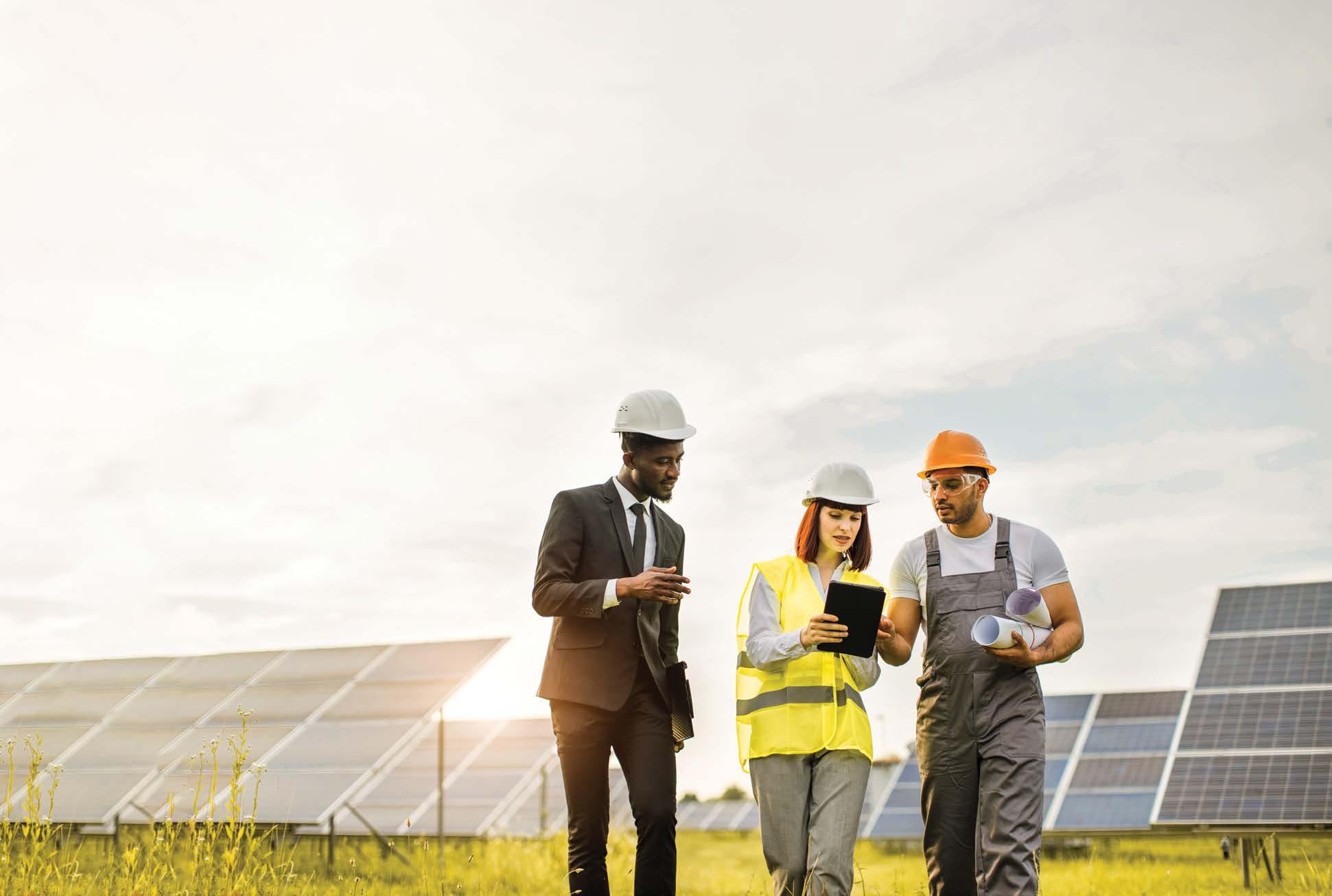
Our Green Buildings Finance Programme provides up to 100% property finance ranging from R500 000 to R50 million to established entrepreneurs with a viable business who want to invest in green buildings and achieve green building certification. We finance the purchase, construction, and/or retrofit of buildings if their designs are certified under an eligible green building certification.
Extra benefits:
The cost of green certification is covered by a nonrefundable grant of up to R150 000. We offer a rebate of up to 40 percent of the capital expenditure needed to green your building and achieve green buildings certified status.
Business Finance Property Finance Property Joint Venture Fund
Mentorship and Technical Assistance Green Buildings Finance
www.businesspartners.co.za
Small businesses urged to
GO SOLAR
or small businesses looking to ride this wave on the path to post-pandemic recovery, the key is to go solar. This is the opinion of Jeremy Lang, chief investment officer at independent small- and medium-sized enterprise (SME) financier, Business Partners Limited. Prior to the Budget Speech, Lang aired hopes that “large-scale interventions” would be on the cards for the small business sector in the form of much-needed relief measures.
In light of the almost single-minded focus on boosting embedded generation efforts through various fiscal measures and policy reforms, this year’s speech delivered little in the way of SME-specific relief. It did, however, propose several measures that speak to the urgent need for government to address the resounding impact that rolling blackouts
On this, Lang suggests that South African small businesses review the viability of installing solar energy systems to power their operations. “Not only will this help to alleviate pressure on the national grid, but it will also ensure business continuity – a vital factor given that loadshedding will likely persist for a long while longer. This could also bring good news for small businesses in the formal sector, who will realise gains in the form of a 125% deduction in tax in the first year for

Further state-led interventions aimed at benefiting the SME sector include the government’s proposal to provide solar-related loans for SMEs on a 20% first-loss basis. “What this means essentially is that going forward, small businesses will be able to secure loans from finance providers where the National Treasury will assume 20% of the initial loss. This will help to mitigate the total risk on behalf of lenders and hopefully make these loans more accessible to a wider base,” explains Lang.
in reaching out to the thousands of small businesses in need of relief, facilitating a streamlined loan application process and deploying funds efficiently,” says Lang.
Overall, government’s R5-billion investment into the expansion of the renewable energy tax incentive is a welcomed development, in tandem with the decision not to increase fuel levies.


Additionally, this year’s extended Budget Review revealed that the Department of Small Business Development has been allocated R2.8-billion as part of a fund to support 12 000 townships and rural enterprises. The measures on which these funds will be spent remain unclear, but as Lang asserts, “a meaningful impact on informal SMEs and the economy can be made by funding a concerted effort to formalise the many township and rural businesses that exist in South Africa.
“In pushing the agenda to formalise these businesses, government will achieve the dual purpose of ‘providing more support and regulatory protection to small businesses, while expanding the tax base.”
This development will likely form part of the proposed Energy Bounce Back Scheme, set to launch in April 2023 – an extension of the Bounce Back scheme initiated during the pandemic years to assist SMEs in recovering Covid-19-related losses. On the effectiveness of this particular measure, Lang remains hopeful that the new solar-directed slant of the scheme will attract more uptake than its predecessor which saw only R140-million in loans being approved and R77-million disbursed of the proposed R15-billion.
“This is where the cooperation of state entities, governmental departments, private sector players and financiers will play a crucial role
On this Lang believes the temporary diversion of focus to a more consolidated effort to solve the energy crisis is well-warranted and that a “solution that includes and benefits small businesses is a solution that benefits all South Africans”.
As he concludes: “In light of the changes that are afoot in South Africa’s tax regime, small business owners would do well to seek the advice and guidance of tax professionals and remain informed, via the available knowledge bases, to understand how they can make the most of the tax-related benefits on offer for the foreseeable future, this is where further relief will stem from.”
011 713 6600
enquiries@businesspartners.co.za
www.businesspartners.co.za
29 ECONOMY
If anything, the 2023 Budget Speech revealed that devising a targeted plan to solve South Africa’s ongoing energy crisis remains the government’s top priority. The immediate future will see a concerted and collective focus on bringing together the public and private sectors in a bid to fuel the clean-energy transition and end loadshedding.
For small businesses looking to ride this wave on the path to post-pandemic recovery, the key is to go solar.
Jeremy Lang, Chief Investment Officer, Business Partners.
The future of ONSHORE WIND TURBINE SOURCING

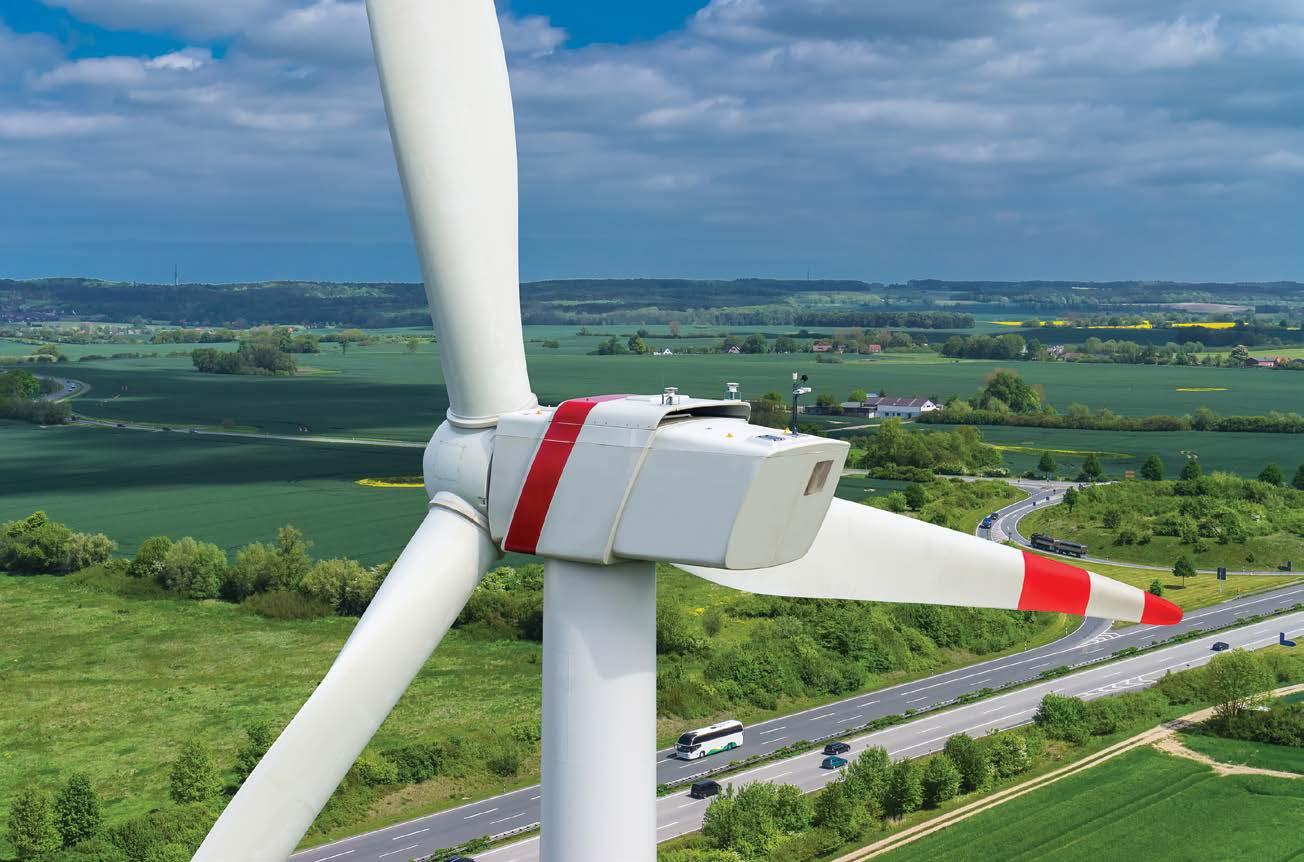
With bold decarbonisation targets, the demand for renewable energy will skyrocket with an estimated 2 400GW of new capacity installed by 2030. The strong pressure to deliver against these targets will escalate demand-side competition.
BY KEARNEY CONSULTING*
At the same time, original equipment manufacturers (OEMs) for turbines are in financial trouble despite having full order books and receiving record-level order intakes (see figure 1). GE Renewables reported a sharp drop in their EBIT margin, from -5% in the past few years to a devastating -26% in 2022 Q3. Siemens Gamesa recently announced a layoff of roughly 2 900 employees, and Nordex and Enercon have been facing financial troubles over the past few years. Even Vestas, the only profitable large western OEM up to now, has reported a -11.9% EBIT margin year-to-date.
30 ENERGY
Three factors are triggering OEMs’ troubled performance. First, the historically strong negotiating power of large utilities has been upholding strong pressure to reduce the levelised cost of energy (LCOE). Here, their relentless focus on capex reduction and a limited view on the full potential of project optimisation decreased the margin of turbine sales to a bare minimum. Second, OEMs are facing protracted costs of quality issues caused by the high pressure on fast innovation cycles. Third, the current supply chain issues and sharp
rises in raw material costs cause severe troubles. Contracts with long lead times and often limited contractual inflation clauses make it difficult for OEMs to fully pass rising costs on to their customers, pushing the companies into the red.
CHANGES LIE AHEAD
In an oligopolistic market structure, these losses are unsustainable and limit investments in additional capacity. In a market with fast-growing demand, this puts the sufficiency of wind turbine supply in the short- to medium-term future at a heavy risk. Market fundamentals will shift the negotiating power from the demand side to turbines suppliers – a process that has already started.
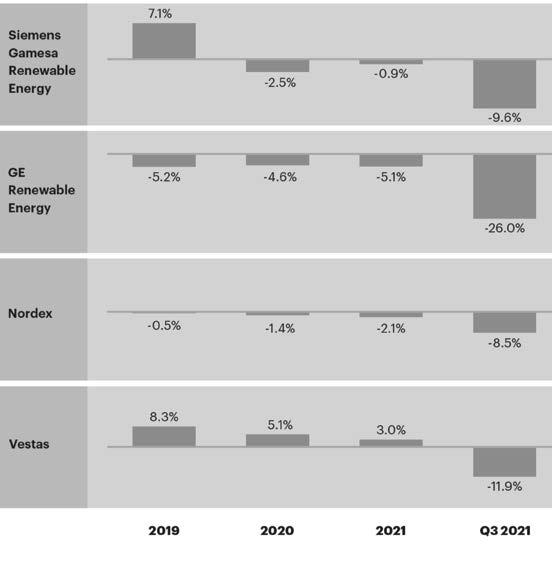
This will impact costs and ultimately capacity access for utilities and project developers:
• Suppliers will gain more pricing power, driving turbine prices up beyond the already elevated level of more than 30% year-on-year.
• Suppliers will select their preferred customers, and ill-prepared customers will find it difficult to place orders at all.
This new paradigm will require a strategic shift in wind turbine sourcing.
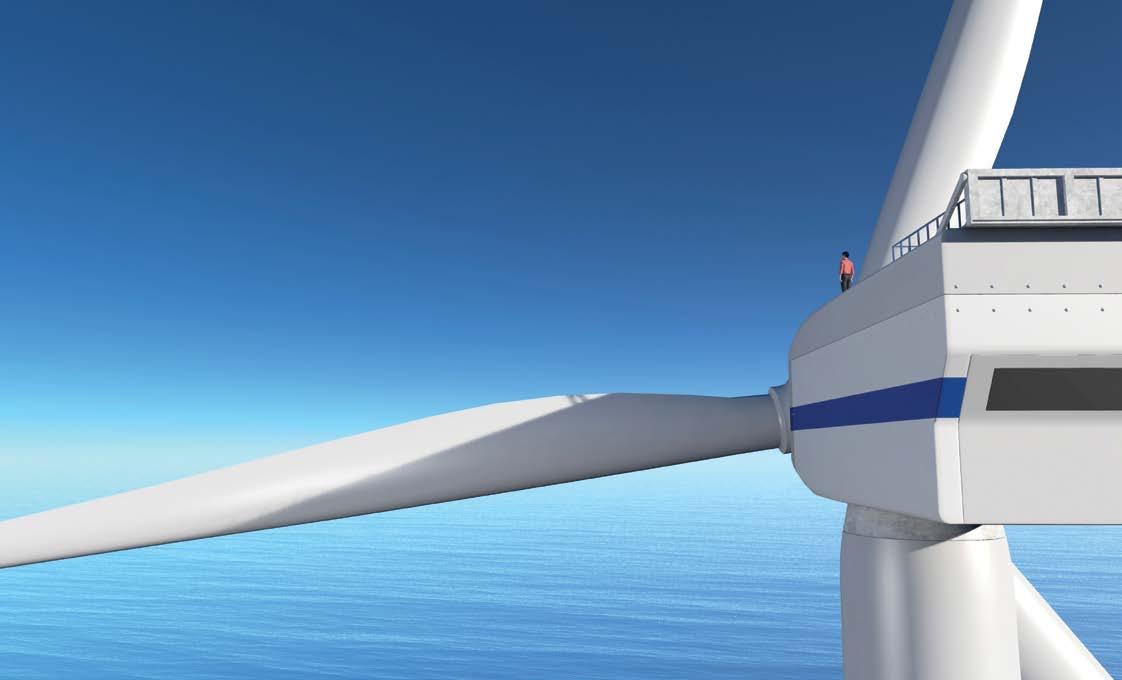
CLOSER COLLABORATION
In traditional sourcing approaches, turbines are procured project by project in individual tenders, sometimes enhanced with bundling of multiple projects to make use of the economy of scale. This approach is best used in cases of very large, complex projects where the sheer size of the projects is enough to entice the OEM to collaborate closer. However, it fails to unleash the full potential to create value over the complete pipeline.
Framework agreements create value by standardising procurement processes across projects and by capturing scale advantages for large pipelines. Best-in-class framework agreements contractually stipulate a higher degree of collaboration by the OEM – and in exchange offer the commitment of projects to be built with the participating OEM’s turbines.
31 ENERGY
In times of uncertain supply, setting up an even closer supplier relationship – a strategic partnership – can be very attractive for both parties.
Figure 1. Turbine manufacturers are reporting sharp drops in their margins. Kearney Analysis
In times of uncertain supply, setting up an even closer supplier relationship – a strategic partnership – can be very attractive for both parties (see figure 2). The utility company commits to equipping a large share of its pipeline with wind turbines from one OEM. In return, the utility receives preferential access to turbines, extended transparency on costs and technical specifications, and most importantly, the OEM’s support in the development phase to optimise the project.

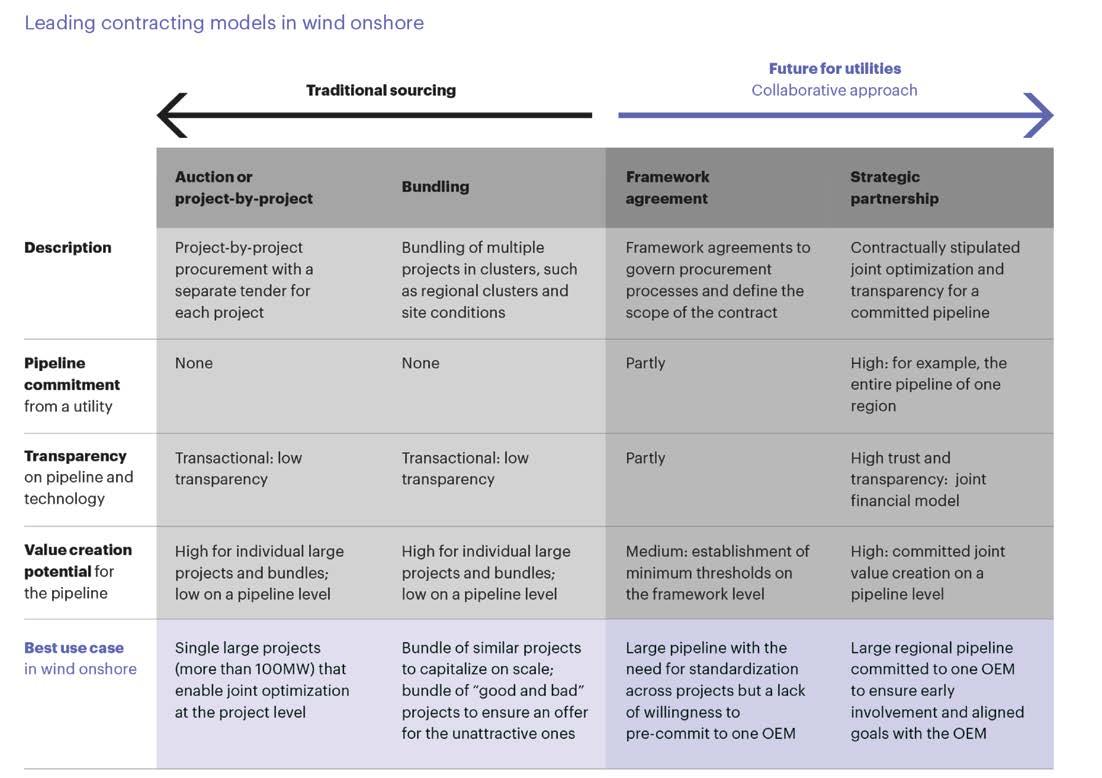
Although there is no silver bullet and the contracting method will need to fit the unique needs of the business, leading industry players with broad pipelines have been turning to more collaborative approaches. The goal is to establish successful long-term partnerships to shift the dynamic to a more balanced and mutually-beneficial relation.
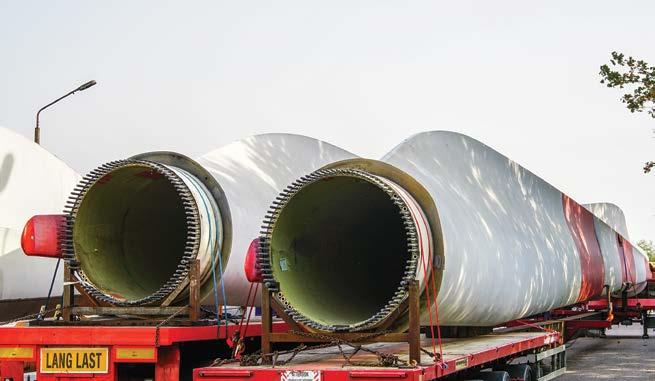
HOW TO WIN
Setting up a successful strategic partnership is not straightforward and requires sound preparation. In our experience, there are three main elements to sustainable win-win outcomes:
Securing a reliable and resilient project delivery. Enhancing the reliability and resiliency of project delivery requires trust and extensive two-way transparency between the utility and the OEM. Greater visibility on the utility’s pipeline lengthens the planning horizon for the OEM, which can consequently profit from enhanced operational and strategic optimisation leeway. The utility, on the other hand, can count on timely turbine deliveries and execute projects better on time and on budget. In addition, extended transparency on
32
Figure 2. Utilities and turbine suppliers can create win-win partnerships.
ENERGY
OEM-proprietary technical data, especially for upcoming turbine types, can benefit both parties for joint first projects with the new turbine generation.
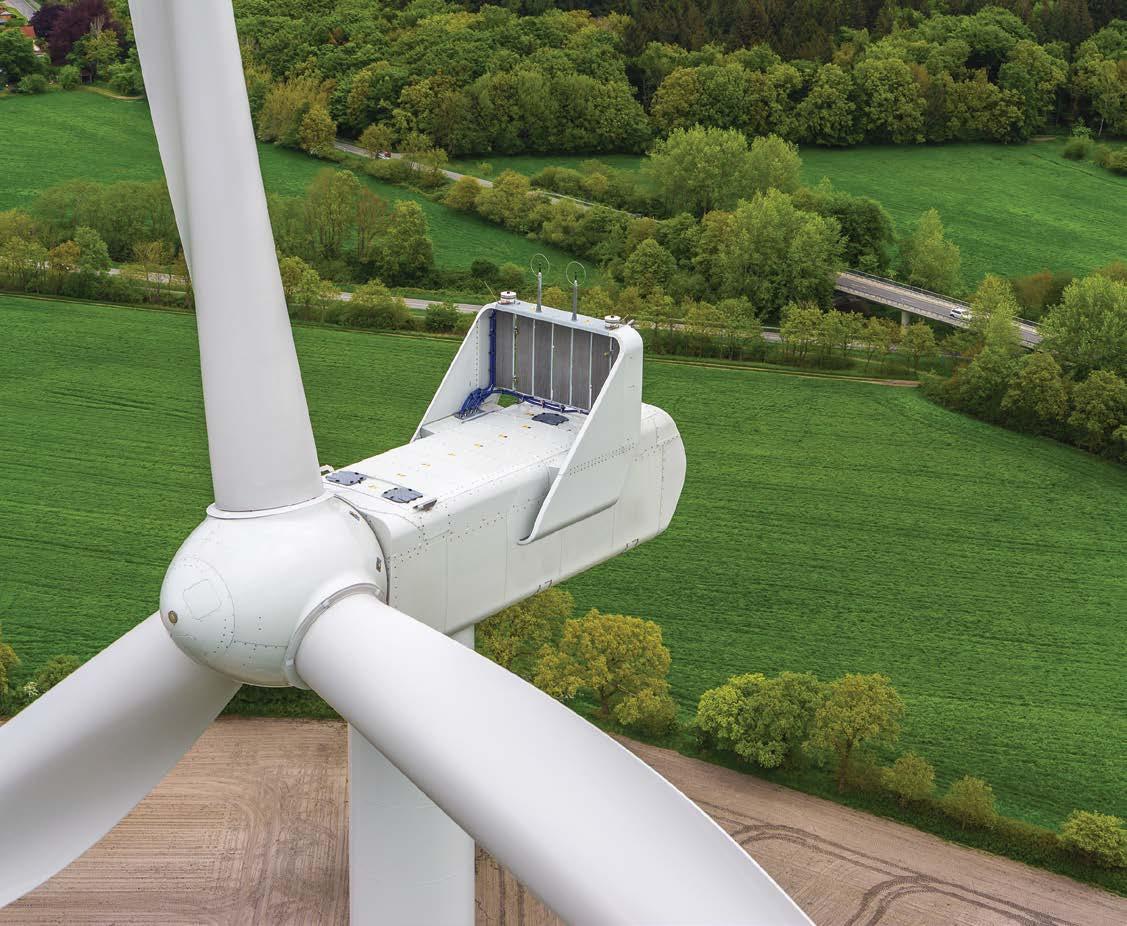
Collaboratively optimising projects to enlarge the value pool. By jointly optimising projects in early development phases, the OEM and the utility can unlock value pools that would not be achievable for the utility alone. Tackling the full envelope of cost and yield can reduce LCOE by up to 30%. Without fair sharing of the additionally generated value, the OEM would not optimise projects to their full potential, but only to the point it is profitable for the OEM (for example, up to a certain threshold value, such as target LCOE).
Important elements of joint optimisation include:
• Comprehensive optimisation of turbine selection and layout in iterative workshops across the OEM’s and utility’s turbine, electrical, and civil engineering. Configuration decisions and power curve customisation are made on a component level, based on net present value and LCOE impact.
• Transparent, bottom-up planning of operations and maintenance costs over asset lifetime, leveraging OEM data and best practices.
• Lifetime operations and maintenance cost and yield optimisation, enabled by access to anonymised turbine data beyond the own fleet, such as historical failure rates.
Going beyond traditional partnerships. Best-in-class partnerships go beyond joint LCOE reduction and supply security – pushing the
potential to create value even further.
Successful extended partnerships in the market include:
• Joint M&A activity. Combined market knowledge to identify opportunities and exclusivity for a first call in M&A opportunities.
• Asset and liability pooling. Pooling assets and liabilities across projects to enable portfolio-level benefits.
• Joint market-entry strategies. Entering new markets with combined power and aligned interests.
• Equity stakes. Perfectly aligning long-term incentives, such as with a joint venture or acquisition of an equity stake in a partner.
THE WAY FORWARD
So how can you find out if closer OEM collaboration and a partnership approach are the right strategies for you? We suggest starting with three steps:
• Review your project development approach and identify the most pressing issues.
• Assess the robustness of your current procurement strategy and your collaboration model with OEMs.
• Analyse your portfolio fit for a partnership and quantify the potential joint value creation.
33
ENERGY
*Article written by Hanjo Arms, partner, Oskar Schmidt, principal and Jan Weber, consultant.
Framework agreements create value by standardising procurement processes across projects and by capturing scale advantages for large pipelines.
Wind energy’s LEADING ROLE in South Africa’s ENERGY ACTION PLAN
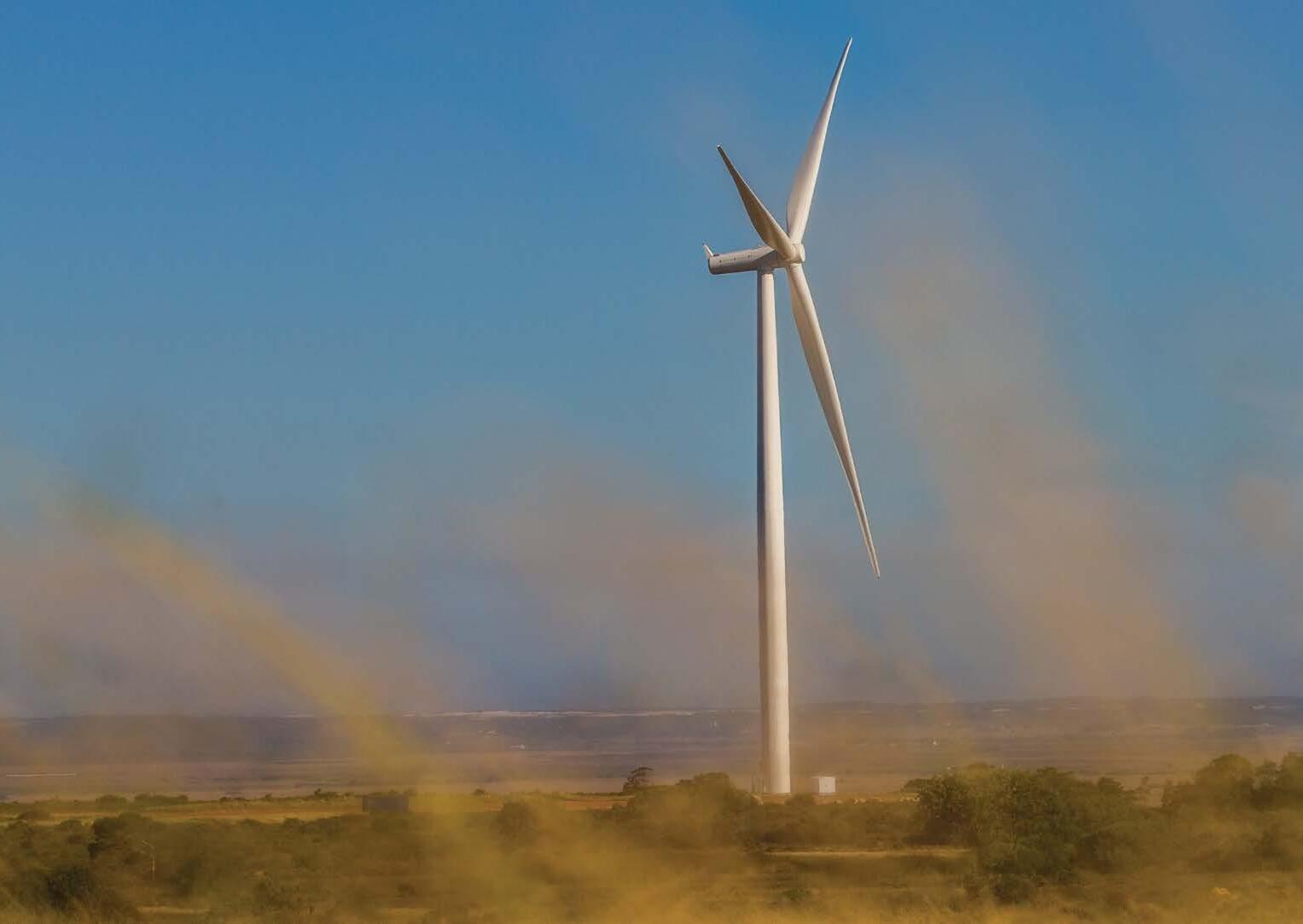
SAWEA believes that for the country’s energy security challenges to be addressed, a holistic view of available renewable energy sources should be considered. Not only does this provide consumers and businesses with options; it will also enable a fertile economic environment.
BY SAWEA
Following the National Energy Crisis Committee’s six-month progress update on implementation of the Energy Action Plan (EAP), released earlier this year, the South African Wind Energy Association (SAWEA) has commended the government’s transparency and inclusion of the public on its progress towards addressing energy security, and has welcomed the changes. However, it has advised that there are a number of key focus areas that require additional intervention and swift action within the five objectives outlined in the plan, with a clearer scope of wind energy integration, mainly infrastructure investment in wind projects. Wind, as one of the most cost-effective renewable energy sources, has significantly demonstrated its positive economic contribution with a total procurement by wind IPPs during construction and operations to date amounting to over R9-billion.
Fundamentally, the Energy Action Plan is a tool that will hold government accountable to ensure thorough deployment of the identified objectives to ensure an energy secure future that includes the integration of wind energy.
Unpacking these objectives and what the expectations for the wind sector are, SAWEA’s chief communications officer, Morongoa
34 ENERGY
Accelerated procurement through the REIPPP programmes and increased private offtakes is what is needed to resolve the energy crisis in the country.
Ramaboa, explains in relation to the EAP’s overall long-term objective to achieve energy security, “We support the various interventions and those that are in the pipeline. More so, we welcome the fact that renewable energy is being embraced by government through the Cabinet’s endorsement of the Just Energy Transition Investment Plan, as well as the prioritisation of solar, wind, gas and storage projects at nine of Eskom’s power stations. We believe that this will ultimately support our urgent need for energy security, effectively reducing loadshedding and the resulting detrimental impact on our green economy.”
Furthermore, the Plan’s approach to accelerating private investment in generation capacity, through the removal of the licensing requirement for generation projects of any size, the reduction of timeframes for regulatory approvals, as well as the establishment of a “One Stop Shop” for energy projects through Invest SA, are interventions that SAWEA welcomes.
However, SAWEA also values public procurement that allows a baseline of investment and creates stability in a growing industry, noting that there is room for both markets to ensure that energy security is achieved across the entire value chain in both private and public spheres. “The ideal is to create an environment that encourages and accelerates investment injection into the economy, removing the pressure from public fiscus, and to stimulate the private sector to invest in their own energy supply and furthermore create new industries,” adds Ramaboa.
SAWEA believes that the reduction of timeframes for regulatory approvals based on the streamlining of environmental processes will significantly accelerate the development of large-scale transmission infrastructure. And, while it acknowledges that the state utility has conceptualised various programmes that will allow for the procurement
of additional power when the grid is significantly constrained, it expects government to maintain consistency in as far as the capacity procurement is concerned.
While a step in the right direction, the Association warns that accelerated procurement through the trusted REIPPP programmes and increased private offtakes is what is needed to resolve the energy crisis in the country. SAWEA reiterates that a clearly-defined queueing system needs to be urgently implemented with a balanced view between publicly and privately procured electricity. It additionally advocates that Ministerial determination for over 18 000MW of new generation capacity from wind, solar and battery storage be prioritised since it was published in August last year.
The EAP’s intention to enable businesses and households to invest in rooftop solar is viewed as a good start to providing reprieve from the adverse effects of interrupted electricity. This requires the development of a net billing framework for municipalities to enable customers to feed electricity from rooftop solar installations onto the grid by the utility.
“To complement this move, SAWEA is looking at investment opportunities to integrate wind energy for the use of businesses and households to supplement the use of PV panels, especially in areas that prone to strong wind conditions,” continues Ramaboa.
SAWEA has welcomed the establishment of a National Energy Crisis Committee (NECOM) as it demonstrates government’s willingness to collaborate with a wide variety of expertise across different spectrums within the energy mix. The Minister of Electricity’s role of coordination and working with the Minister of Mineral Resources and Energy to provide the solutions to transform the energy sector certainly inspire confidence in the industry and amongst investors.
With the current energy insecurity, there’s a significant need for South Africa to have an enabling policy environment that stimulates economic growth and reliable energy supply, as well as one that builds new human capital to meet the needs of a growing renewable energy economy.
According to the Integrated Resource Plan 2019, the South African power system includes 3.7GW from renewable energy, namely wind, solar PV and concentrating solar power (CSP). This is viewed as an under estimation given the movement in private offtake market. SAWEA has noticed a trend of an increase in private offtakers sourcing renewable energy, typically wind and solar PV. We believe that this will drive a competitive market able to provide new generation capacity in a cost-effective manner. This attests that the wind sector is a driving force of economic development in South Africa.
“To realise our vision of becoming a thriving commercial wind power industry that supports government in fulfilling its mandate to secure energy for South Africa, we cannot afford to have a repeat of the latest failed public procurement bid window (BW6), which has resulted in the loss of investment and market confidence. Hence, the current system for allocating grid access remains a pressure point as it marginalises capable and willing organisations that can contribute significantly to the supply of electricity. So, although additional determinations are welcome, this cannot be in the absence of a solution to increased grid capacity and to ensure fair access for additional projects that are currently inactive,” concludes Niveshen Govender, CEO of SAWEA.

35 ENERGY
The ideal is to create an environment that encourages and accelerates investment injection into the economy.
The wind sector is a driving force of economic development in South Africa.
CLIMATE IMPACT IMPERATIVES: resilience and decarbonisation
BY SRK CONSULTING
“While decarbonisation is about limiting the company’s impact on the environment, resilience is about being prepared for the environment’s impact on the company’s operations,” says Burmeister. “Every responsible organisation needs to be addressing both these imperatives – not just one or the other.”
DECARBONISING THROUGH EFFICIENCY
Decarbonisation continues to be a strategic priority for mining companies, with targets and achievements being reported in greater detail as part of integrated reporting standards and requirements. Among the more well-publicised of these efforts are new and relatively unproven technologies that mines are still testing – such us hydrogen trucks. However, SRK Consulting managing director, Andrew van Zyl, points out that many improvements in mines’ carbon footprints have been achieved over the years – but referred to simply as efficiencies.
“There are many costs in mining that are proxies for carbon footprint – such as diesel consumption in mining trucks or energy consumed in crushing and milling phases,” explains Van Zyl. “As engineering consultants, we assist clients to reduce fuel consumption through optimal design and slope of haul roads – all contributing to the decarbonisation effort.
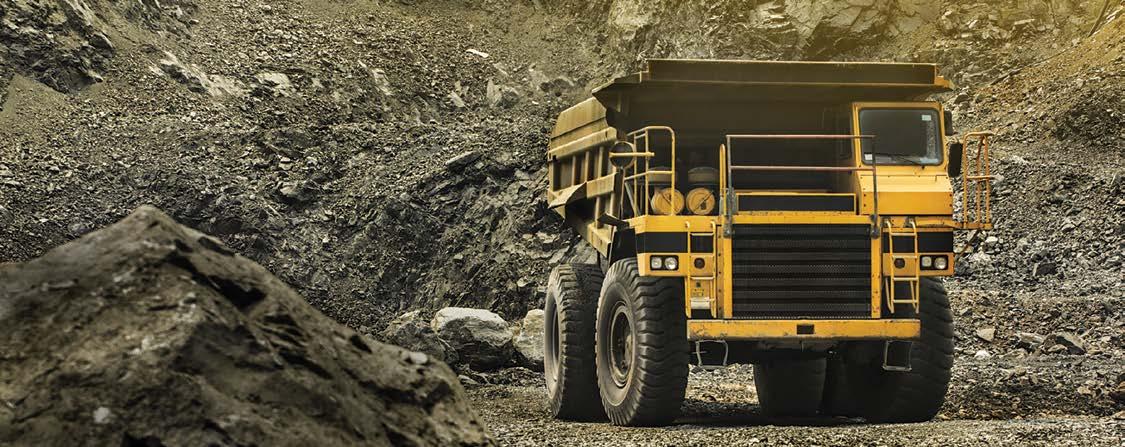
“The application of novel carbon-reducing technologies in mining projects remains important, but it does have implications for new projects’ bankability. If there is insufficient evidence of how well or at what cost a key item of equipment will work, for instance, then it will undermine the process of proving a reserve and establishing the project’s profitability.”
THE OTHER SIDE OF THE COIN
Van Zyl indicates that there is a strong imperative in mining and other sectors to contribute to reducing carbon emissions, even though the climate change trend is well under way.
“As good corporate citizens, it is incumbent on all stakeholders to commit to a lower carbon future even if the positive results are many decades in the future,” he says. It is critical that, while still undertaking decarbonisation initiatives, organisations need to simultaneously build resilience to prevent potential climatic changes affecting their operations. In the mining industry, the relevance of climate change is direct and explicit in tailings dam management.
IMPACT ON TAILINGS DAMS
“The Global Industry Standards on Tailings Management (GISTM) which the mining sector has committed to, has made it mandatory that mines build climate change into their forecasts and strategies,” says Burmeister.

At a recent SRK global climate action workshop, an SRK tailings expert made it clear that climate change was already evident and the GISTM now made it mandatory that tailings dam owners develop and apply adaptation strategies in their design and management of these structures. The workshop also looked at the various tools available for adapting to climate change and developing more resilience.
“While a key focus was on tailings dams, these tools are applicable to all types of adaptation – to try and understand what the future is going to look like,” Burmeister adds. “They include models to predict how climate patterns will change, so that companies can start adapting their plans to suit changed conditions.”
36 DECARBONISATION
Resilience and decarbonisation are two sides of the same coin for companies as they evolve their strategies toward climate change, according to SRK associate partner and principal scientist Philippa Burmeister.
Philippa Burmeister.
Observed data is critical to understanding both the current and future climate.
The same tools also have value for industry and agriculture – as they all need to adapt to potential climate extremes, increased temperatures and changes in rainfall patterns.

FINDING THE RIGHT MODELS
Burmeister highlights that there is a vast amount of data available on which models can be developed, but it is difficult to know which models and data are most relevant to the site in question.
“An aspect that received extensive discussion at the workshop was developing our own in-house capacity in climate change resilience – a key area of which is the range of models available for climate forecasting,” she adds. “Each model has its own advantages and disadvantages, and we have to advise clients on which ones best suit their location – and how to correct bias using observed data.”
An important aim of this work is to generate a selection of scenarios based on data which comes with a relatively high level of confidence. Building on SRK’s existing skills in this field, the process is working towards every SRK project team having solid insights into how the climate will change for the sites at which their projects are based. This allows the engineers and scientists in each team to reflect on the impact such changes are likely to have for the activities of the project covered by their specific disciplines.
OBSERVABLE DATA
“If future rainfall figures can be to some extent quantified, then it gives engineers a basis on which to assess possible impacts and responses in the mine’s daily operations,” she says.
She emphasised the importance of confidence in data as a vital starting point to building better climate change resilience. While models are useful, they need to be tested and “trained” with the
use of observable data from the site itself. This meant that mining, industrial and agriculture sector players need to implement effective monitoring systems for climate indicators such as temperature, rainfall, humidity, evaporation and wind speeds.
“This on-site meteorological monitoring – when conducted accurately – makes it possible to select the most appropriate models for a site, and to improve the performance of those models over time. Data confidence is the single biggest hurdle that we need to overcome, and observed data is critical to understanding both the current and future climate.”
RISK FROM EXTREMES
Climate change resilience is not just about understanding how average temperatures and rainfall will change but also how historical climatic patterns and extremes will change. Indeed, climate change is expected to have a greater impact on extremes – meaning that there may be even more rain in already rainy months or spikes in temperature in the hottest times of year. It is these extremes that pose some of the greatest risks to operations.
While this has implications for mining, it will similarly require consideration from other industries that may need to carefully consider the operating levels on equipment or storm water designs. Potentially the greatest impact will be felt in agriculture, where even a small shift in the timing of a dry or wet period could have a devastating effect on crops.
“The focus will remain on decarbonisation as companies align with growing expectations from investors, funders and other stakeholders,” concludes van Zyl. “However, climate change adaptation to build resilience will allow organisations to prevent disruptions, damage and losses associated with current and future climate changes.”

THE FOURTH SOUTH AFRICAN CLIMATE CHANGE TRACKING REPORT | The Department of Forestry, Fisheries and the Environment | [2021]
South Africa is undertaking a variety of actions to respond to the causes and effects of climate change. South Africa’s response, through adaptation and mitigation actions, is guided by the National Climate Response Policy (2011) and the National Climate Change Adaptation Strategy, and with international commitments as stipulated in the updated Nationally Determined Contributions (NDC).
Consideration needs to be made to come up with smart indicators to be tracked overtime to inform policy and decision-making. The development of relevant and strategic climate indicators requires taking a step back from the siloed approach to to focus on the system approach that integrates environmental, social and economic dimensions. The environment is intricately entwined within the wider societal and economic systems which cannot and should not be treated as separate entities.
In recognising this complex interconnectedness, the approach to developing indicators to track South Africa’s progress on the national response to climate change takes a systemic approach. This holds the promise of capturing much of the systemic impact of climate change and of response measures. A systemic perspective is necessary to gain a deep insight into climate change and climate change impacts and is important for mobilising strategic responses to climate change.
37 DECARBONISATION
READ REPORT THOUGHT [ECO]NOMY greeneconomy/report recycle Climatic realities The energy transition Water and climate change Social vulnerability Sustainable urban centres 09 69 123 141 165


We are morally obliged to demand ENVIRONMENTALLY SOUND BATTERIES to store RENEWABLE ENERGY
BY REVOV*
There’s always a tinge of irony that what should be an environmentally conscious decision is forced by the inability of the national power utility to produce enough electricity and volatile fuel prices which make running internal combustion generators exceedingly expensive – especially during prolonged periods of loadshedding at higher stages.
Be that as it may, some would argue that it doesn’t matter how one arrives at the correct destination, what matters is that they have arrived. So, let’s talk solar. Very simply, as everyone reading this will understand, solar panels convert sunlight into power that can be used in homes and businesses.
However, anyone who watches the Eskom updates daily on power usage will see that renewable energy is not fixed. There are periods where more is produced, and periods where less is produced. This is the nature of the environment. Either there is good sunlight or it is overcast, either there is plenty of wind or there is not.
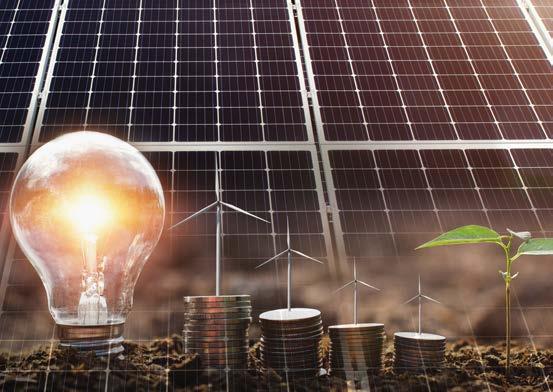
It’s here where many who have not yet seen the light – pun intended – miss the point, and also why there comes a time in every national dialogue that batteries and large battery installations come into the spotlight. This is because batteries, configured correctly in a renewable energy installation, can store the power being produced to provide a constant, reliable and predictable flow of electricity.
Understanding this is the first step of an environmentally responsible citizen. The second step is in appreciating that the battery you use affects whether you are making the most of the clean power being produced. Ask yourself: are you even aware of the carbon footprint of the batteries stacked in your garage or warehouse.
Lithium iron phosphate batteries have proven, time and again, to be the best chemistry for battery storage. Lithium iron phosphate is safe, reliable, effective and enjoys a much longer lifespan than other battery types such as gel or lead acid. However, not all lithium iron phosphate batteries are the same.
Some, which are called LiFePO4, are made – at the outset – for storage solutions. Minerals are mined, beneficiated and configured into batteries for the storage market. This market competes with the electric vehicle (EV) market, where increasing demand results in increasing prices.
Even worse, a new class is emerging. Class B storage cells, which manufacturers and white labelers are now calling “cost effective”, with a reduced warranty and cycle life. Watch out.
The batteries made for the EV market are engineered differently, to withstand harsh operating conditions such as higher temperatures and charge and discharge rates. Every EV needs to change its battery when the weight is no longer justified by the output. However, within these batteries that are removed are some perfectly sound individual battery cells.
Instead of throwing the whole battery into a landfill somewhere and
*Written by Lance Dickerson, MD, REVOV.
poisoning the planet, environmentally conscious engineers take these good battery cells and configure them into storage batteries, which we call 2nd LiFe. These batteries have comparable lifespans to LiFePO4 batteries, with the added benefit of being able to withstand harsh operating conditions.
Understanding this is crucial: the batteries are not secondhand –they didn’t exist until now. Rather, their individual cells are made up of the good cells that were retrieved from EV batteries and repurposed into storage battery units.
It’s here where the homeowner and business owner can drive positive change and a crucial environmentally conscious mindset in South Africa’s revolution towards renewable energy: even if it has been forced on them. The carbon cost of 2nd LiFe batteries has already been paid. These batteries are as near to carbon neutral as one can find, whereas the LiFePO4 batteries come at a significant carbon cost that includes mining, shipping, beneficiation and complex logistics all the way to installations near you.
The 2nd LiFe battery cells paid their carbon dues in their first life in EVs. Make no mistake, LiFePO4 batteries are still far better and cleaner options than the archaic chemistry called lead acid. If you’re undecided, always choose lithium over lead.
Customers can drive a mindset shift. It’s about time more people look around and appreciate the immense damage we have caused to the environment. Extreme weather events and entire ecosystems are at risk. This means it is not only admirable but non-negotiable that we put the planet front and centre in all investment decisions – especially those that harness clean energy.

39 ENERGY
The energy crisis in South Africa has fundamentally changed how most people see electricity, and it took a leap in the right direction when Finance Minister Enoch Godongwana announced incentives for South Africans to invest in solar energy.
Either there is good sunlight or it is overcast, either there is plenty of wind or there is not.
Bringing POWER back to LiFe Green Economy Journal interviews CEO of REVOV
REVOV was founded by Lance Dickerson, former CTO of MTN, Ghana, and Felix von Bormann, former engineering consultant for Sprint, USA. Both highly-skilled engineers bring a combined 50 years of experience to power up the energy storage space.
Please tell us about REVOV. What do you specialise in?
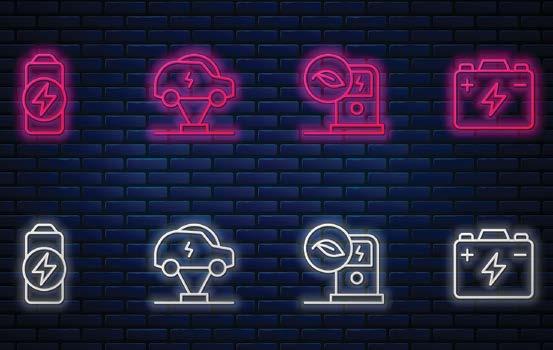
REVOV is an energy storage solutions company that sells lithium iron phosphate batteries either as single units or in powerful systems of multiple batteries, headquartered in Johannesburg with branches in Cape Town and KwaZulu-Natal. REVOV is known for, and specialises in, 2nd-LiFe lithium iron phosphate batteries for the B2B market in South Africa and Southern African region. REVOV has become renowned for its 1st and 2nd-LiFe batteries which provide a compelling case to bring lithium-iron performance to the market at a significantly reduced cost. Rand for rand, REVOV is the go-to for value for money.
What are second-life batteries? Why recycle batteries?
This needs to be clarified at the start: 2nd-LiFe batteries are not recycled batteries, and they are not second-hand batteries. This is an important distinction. REVOV does not sell recycled or second-hand batteries. REVOV sells 2nd-LiFe batteries which are batteries that are built from repurposed cells of electric vehicle (EV) batteries. In other words, when an EV battery is replaced, instead of being discarded, it is taken apart by specialised teams, and individual cells which are still in perfect working order are removed. In REVOV’s case, we have a partnership with a world-leading EV battery company in China. The individual cells taken from the EV battery are then configured and built into 2nd-LiFe batteries with new casings, parts and battery management systems. These 2nd-LiFe batteries have a comparable
lifespan to 1st LiFe batteries, and they can withstand harsher conditions because they are made from the good cells of EV batteries, which are designed for high temperatures as well as charge and discharge rates.

What are the main environmental impacts associated with electric vehicle batteries?
From the extraction of the raw materials to cross-country logistics to shipping and then beneficiation, all the way through to delivery, batteries come at a significant carbon cost. It is perhaps a great irony
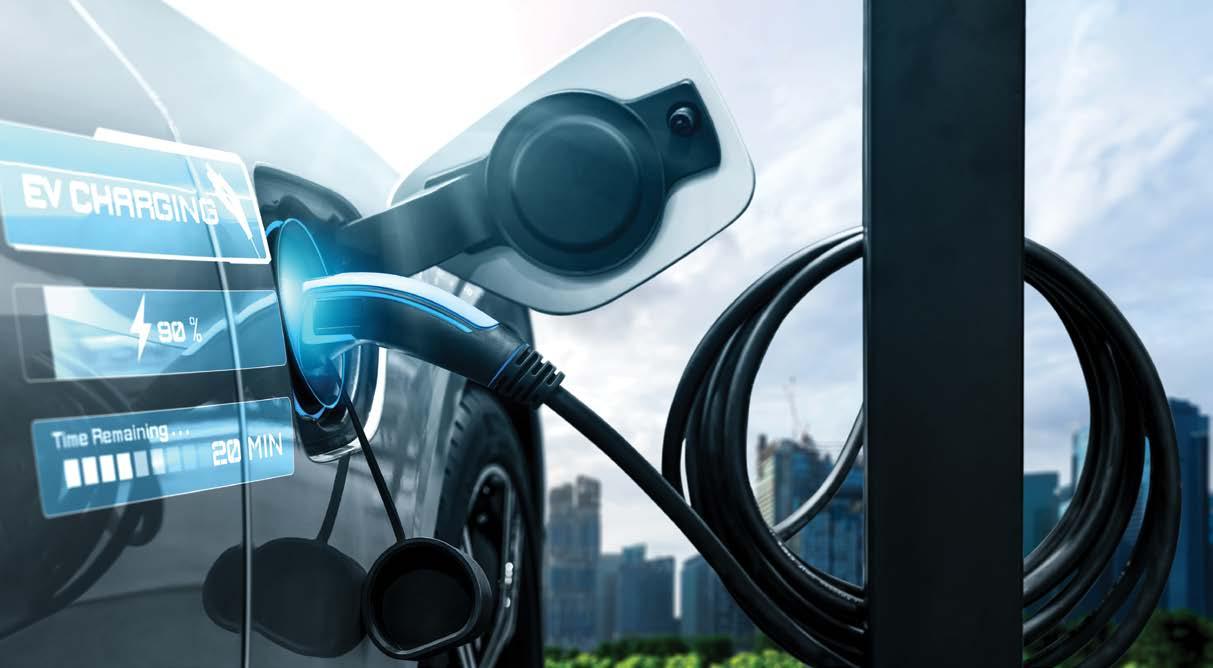
40 ENERGY
that the very technology required to support sustainable electricity storage and mobility is extractive to the planet and comes with its own carbon cost. This is why 2nd-LiFe batteries are a compelling solution for those genuinely interested in “going green” and making decisions that benefit the planet.
The carbon footprint of a 2nd-LiFe battery is as close to zero as possible for a storage battery – precisely because it is utilising the good cells of EV batteries and not relying on newly-mined and beneficiated components. Besides some new cabling and shipping, 2nd-LiFe batteries are without a doubt the most carbon-friendly storage solution.
What are the advantages of REVOV’s 2nd-LiFe batteries?
Comparable performance to 1st LiFe batteries at a significantly reduced cost because we are not affected by lithium supply chain shortages. The company has full local technical support and design and engineering teams, this is crucial. REVOV batteries have support that is local.
IN POWER
Lance Dickerson, CEO of REVOV, in 2016 spent extensive time in the telecoms industry, spending seven years in West Africa working for MTN. It was during this tenure that the the impact of a failing electrical infrastructure was felt while trying to keep the MTN networks up and running. Dickerson investigated and implemented various types of backup and redundant electrical systems, however, the technology at the time was not sufficiently advanced to be able to give a reliable and cost-effective solution. On his return to South Africa in 2011, using the skills developed in the telecoms sector, Dickerson decided to focus on battery backup systems, in an effort to reduce reliability on failing grid infrastructure and the cost of diesel-based backup systems. It was at this point REVOV Batteries was born.

THE SECOND-LIFE EV BATTERY MARKET
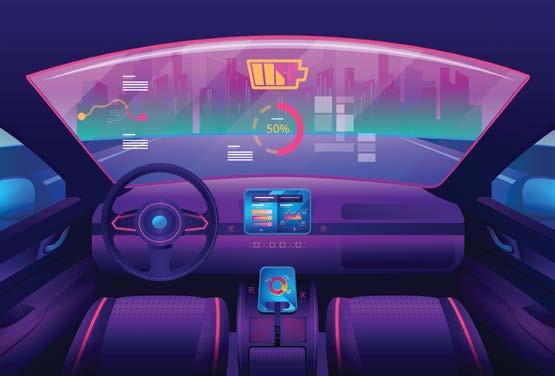

The second-life EV battery market is one of great importance for many reasons. These include adding value to future energy infrastructure, creating a circular economy for electric vehicle (EV) batteries, and providing a lower levelied cost of storage compared to new batteries. The new IDTechEx report, “Second-life Electric Vehicle Batteries 2023-2033”, highlights advancements in the second-life industry. IDTechEx forecasts that the second-life EV battery market will reach US$7-billion in value by 2033.
The bulk of EVs currently use Li-ion battery chemistries, and once their eight-to-10-year initial lifetime has expired, they are usually unsuitable for future EV use. Battery second use (B2U) extends the lifetime of the EV battery. Depending on the State of Health (SOH) and residual capacity of the battery, second-life batteries can be further utilised in less demanding applications, such as stationary energy storage and lower-power electromobility applications.
Stakeholders must make key decisions regarding the end-oflife management of retired EV batteries. Second-life batteries created through a remanufacturing process offer benefits of maximising battery value and extending battery life, whereas recycling results in batteries losing this value prematurely. If remanufacturing is chosen, second-life BESS developers must make further decisions to ensure that the creation of their second-life systems is techno-economically feasible. Remanufacturers must consider several process operations, such as battery procurement, depth of disassembly, testing/grading, and reassembly procedures.
2nd-LiFe batteries are built from repurposed cells of electric vehicle batteries.
41 ENERGY
2nd-LiFe batteries are not recycled batteries, and they are not second-hand batteries. This is an important distinction.
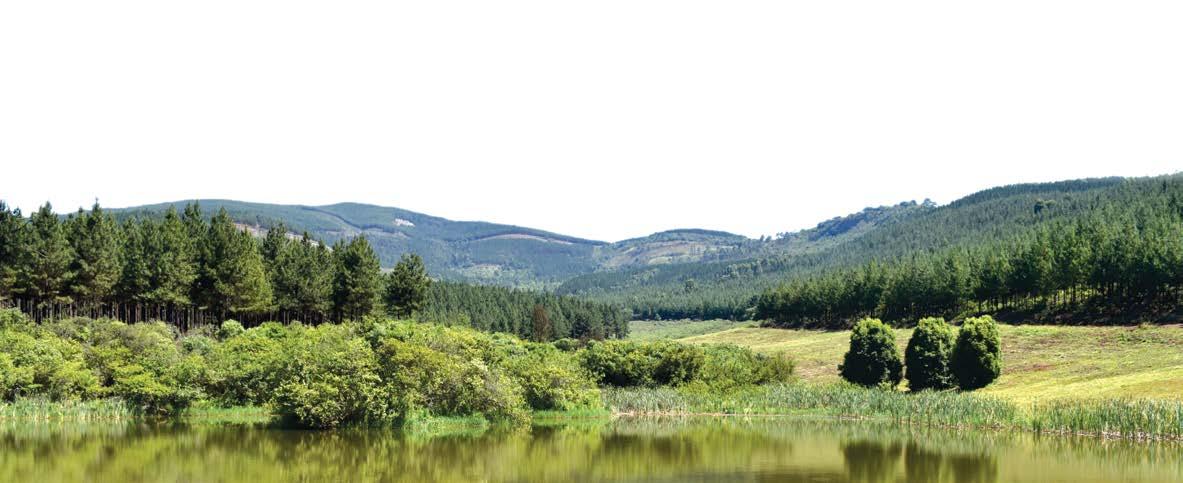


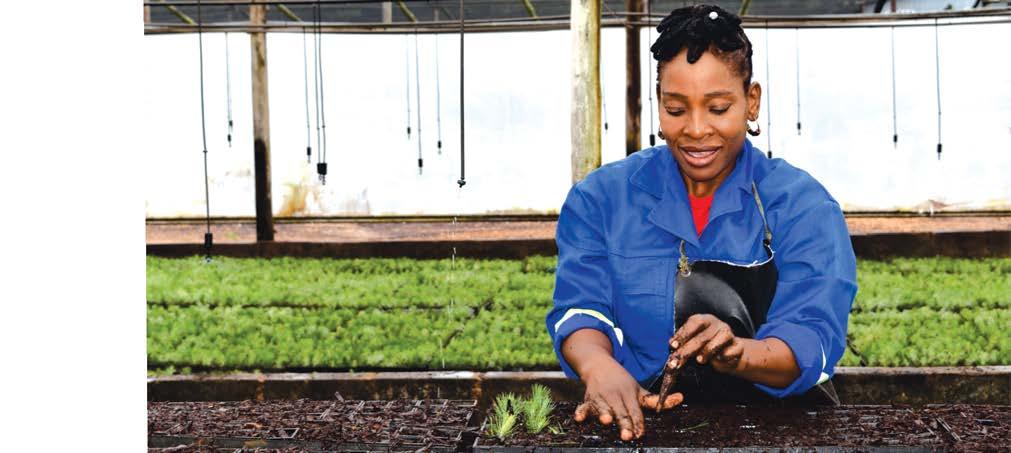
FORESTRY: a greener more sustainable future
BY MICHAEL PETER, FORESTRY SA*
Forestry is fortunate in that it is a sector which can generate its own green, renewable, recyclable and CO2-sequestering feedstock and this can be done in perpetuity, if done in a sustainable manner. As such, the South African forestry sector is truly embedded in the green economy and is the very epitome of a circular economy industry.

Our sector has an excellent track record in terms of environmental conservation. An example of this is that on average only 70% of forestry estates are under timber crops while the remaining 30% of the estate is set aside primarily for the management and conservation of biodiversity and to protect the country’s scarce water resources.
Independent assessments on the state of indigenous forests and grasslands show that plantation forestry estates almost invariably, have much higher levels of biodiversity than any other land uses, including in many cases, even when compared to formally protected nature reserves. This is on account of the strong management and stewardship practices which are implemented by timber growers in South Africa.
Forestry products are the products of the future.
While there are pervasive myths surrounding the industry’s water use, the forestry sector only uses around 5% of the total water used by the irrigated agricultural sector alone, but it returns 27% of agricultural GDP and about the same percentage of jobs. Add to this the major open areas which the industry maintains around water courses and riparian zones, and the picture of the sector’s actual water use and associated environmental practices changes dramatically.
When one considers further that plantations are not irrigated and so they cost the taxpayer next to nothing compared to other water users, as they do not require dams, canals, pipelines, irrigation schemes or purification plants and it becomes difficult for an informed person to conclude that plantations are bad for the country’s water resources in terms of the relative economic, social and environmental returns which the plantation industry’s water produces for the country.
If that isn’t enough to convince most well-informed people, then one should also consider that compared to most other agricultural practices, the forestry industry tills the soil and applies fertilisers and pesticides (the biggest causes of pollution of South Africa’s water resources) at a small fraction of the rate and frequency of that of
most other crops, most of which employ these practices every year. So, water quality coming out of plantations is better both in terms of siltation and the presence of pollutants compared to almost every other land use in the country.
In terms of social sustainability, our industry is found in rural areas where some of the worst poverty exists. To have a sector that provides employment and a myriad of other social returns through Corporate Social Investment (CSI) initiatives that fund education, food security, health care, infrastructure, enterprise creation and social upliftment, etc, is fantastic and something we are very proud of.
Besides the massive CSI programmes, there are innumerable examples of small and medium-scale timber growers and processors, who have opted to continue to use manual inputs in processes, which could be performed far more efficiently through mechanisation and automation, simply because they wish to continue to support the communities in which their businesses operate.
As a country with one of the highest unemployment rates in the world, we should be putting in place mechanisms to incentivise businesses to keep putting people ahead of profits, as without such support, many businesses may not be able to sustain themselves in financial terms, unless they embrace further mechanisation and automation.
In a world where economic recovery is on everyone’s lips, the focus needs to be on the activities that can be truly called green. These will not only drive a more sustainable economic recovery, but also limit our effect on the planet. Sectors, like ours, that place a strong focus on the sustainable use of a renewable natural resource, whose end-products are reusable and recyclable, will provide a blueprint for a green, circular economy going forward.
Globally, people are looking for solutions that will reduce, if not eradicate, our reliance on the extraction of finite resources from our planet. They want a renewable feedstock that can be replenished and repurposed into a myriad of end-products, some which are already replacing everyday non-renewables like plastics and other fossil fuel derivatives.
Forestry products are the products of the future. Be it paper packaging, wood-based fabrics, bio-plastics, timber-based buildings or futuristic green fuels, these forest products capture carbon while they grow and store it while they are in use.
The rapid adoption by the rest of the world of forest products as preferred alternatives to fossil-based products, is proof positive that the entire world sees the value in the circular forestry industry and foresters are proud to be such a key part of the solution to the world’s most critical challenges.
43 WOOD
The fact that the forestry industry operates in and depends significantly on natural and human resources, means that to ensure the financial sustainability of its businesses, those businesses also must ensure their social and environmental sustainability.
*Michael Peter is an executive director at Forestry SA.
Forestry South Africa
Infrastructure Development QUO VADIS
Infrastructure performance, or lack thereof, has become a central topic in news and social media reports of late. Calls persist from economists, captains of industry and the construction sector for the state to increase its capital expenditure allocation to infrastructure development, claiming that this plays a pivotal role in economic development.
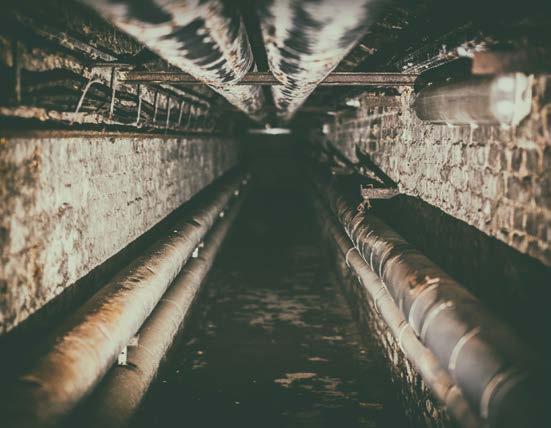 BY LLEWELLYN VAN WYK, B. ARCH; MSC (APPLIED), URBAN ANALYST
BY LLEWELLYN VAN WYK, B. ARCH; MSC (APPLIED), URBAN ANALYST
Regrettably, I have not seen evidence of sustained economic development arising out of increased state capital over the 20 years and more of research into this topic. Despite decades of greater infrastructure investment allocations, infrastructure quality continues to deteriorate.
BACKGROUND
South Africa

In South Africa, Eskom is probably the cause of most of the focus on infrastructure and its failure. This is not surprising: the country faces one of its worst energy crises since 2008. It is estimated that the failure of energy infrastructure cost South Africa around R560-billion in 2022 excluding costs such as lost opportunities, cost to businesses and households and other loadshedding mitigation measures1
However, the focus for increased expenditure is in and of itself not enough to solve the problem. For example, and in the case of Eskom, the time required to execute essential infrastructure projects to upgrade Eskom’s power grid would result, it is claimed, in another 10 years of loadshedding2.
44 THOUGHT LEADERSHIP
The funding for infrastructure is not getting translated to actual projects.
The author notes that despite the speed with which solar and wind power plants could be built, the grid itself does not have the capacity to distribute that power. The power lines he notes, are running at full capacity. This absence of transmission capacity has resulted in the slots for a further 3.2GW of wind capacity not being allocated begging the question of how South Africa can progress with upcoming bid windows 6.5 and 7, as well as the 6GW of renewable generation and 1GW of battery storage that South Africa must procure each year3
To further exacerbate this constraint, the sites for optimum solar power plants are poorly serviced by transmission lines. However, the delivery of solar power plants is a bit easier since the resource is linear throughout most of South Africa and can be utilised locally.
Media reports are also highlighting the interdependencies within the infrastructure ecosystem. For example, seven municipalities in KwaZulu-Natal face crippling water cuts due to loadshedding with reportedly hundreds and thousands of local residents likely to be without running water as electricity-powered engines are unable to pump water because of loadshedding4.

The connection is quite stark: power supply cut-offs can last for up to six hours per day, and when the power is restored, it can take at least an hour for the supply mechanisms, both in the bulk and reticulation networks, to return to full functionality. In the interim, the little remaining storage empties out and there is no replenishment resulting in supply interruptions to consumers. The ramifications go beyond this however, as power-cuts impact on water-treatment plants as well so that water cannot be pumped because it is not treated.

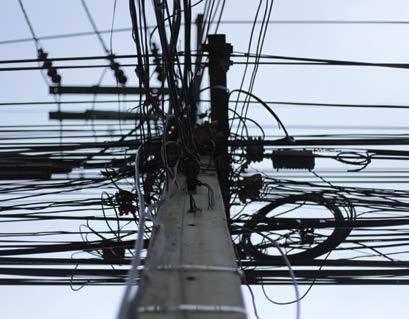
South Africans can be forgiven for blaming government for this failure, and there is good reason to do so. After all, government itself recognises its failures in this regard. However, it would be a mistake to equate infrastructure failure as an exclusively third world problem.
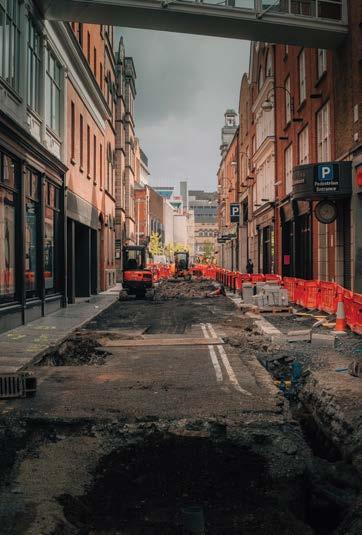

New Zealand
Auckland’s beaches have been overwhelmed this summer by faecal bacteria after the recent bout of heavy rain5. The cause of this has been put down to wastewater overflows that occur when sewage spills out from gully traps, manholes, engineered overflow points or

45 THOUGHT LEADERSHIP
The time required to execute essential infrastructure projects to upgrade Eskom’s power grid would result, it is claimed, in another 10 years of loadshedding.
pump stations. From there it flows into backyards or waterways or the sea.
The floods highlight another systemic failure – the ability to survive major weather events. Suzanne Wilkinson, professor of construction management at Massey University, writes that “after years of neglect, Auckland’s roads and water systems were simply unable to cope with the unprecedented rainfall and flooding seen in January” 6. Just before the floods it was revealed that Wellington had not had fluoride in its water for months. Furthermore, some of the pipes in Wellington that carry wastewater away are literally 120 years old, but because they cannot be seen, they have not been invested in properly 7
The United States
The United States of America – still the world’s richest country – is also not immune from a failing infrastructure. The American Society of Civil Engineers published a report card in March 2021, assessing the overall infrastructure condition as a C-, stating that there was a $2.59-trillion investment gap. The US has never received a higher grade than C- since the report card was launched in 1998 – some 25 years ago8. As Joseph Kane from the Brookings Institute notes, Americans are familiar with its infrastructure challenge “from clogged roads to unsafe pipes to limited broadband access9.”
POSSIBLE CAUSES OF FAILURE
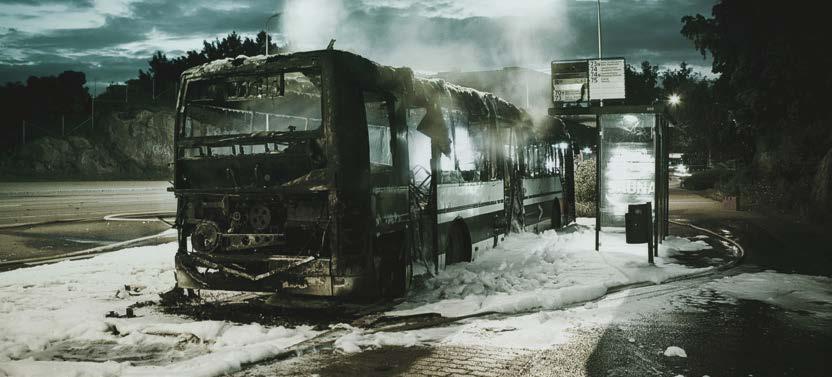
The possible causes of infrastructure failure and consequently the remedial actions identified for South Africa are many, although the same culprits appear consistently in international reports.

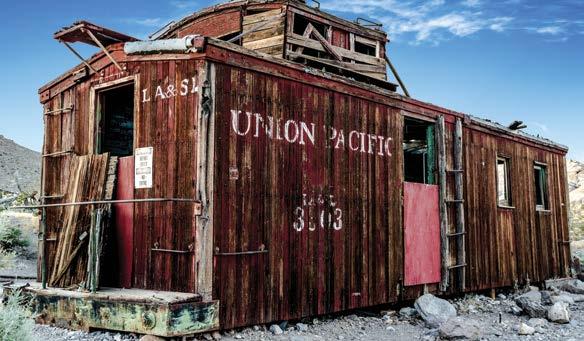
The most cited one is under-investment despite government increasing its infrastructure investment budget. In a headline titled, “Construction industry encouraged by infrastructure development progress”, it is noted that President Cyril Ramaphosa announced in
February 2023 that “by January, projects worth R232-billion were under construction and projects worth nearly R4-billion had been completed10.” The article goes on to cite the president as stating, “This investment will substantially benefit the construction industry and enable large-scale job creation, skills development and poverty relief.”
This is not much different from the announcement by the then Minister of Finance, Tito Mboweni, back in February 2021, that R93.1-billion had been earmarked for economic regulation and infrastructure from consolidated government expenditure of R2.02-trillion each year over the medium term11. This announcement also recognised that much of the country’s infrastructure needed repair or replacement and that government had committed to a R791.2-billion infrastructure drive to address this.
However, investment spending remains below the levels that preceded the pandemic, and 2020 marked the third consecutive year of decline. Yet there is a flip side to this coin: in 2021 National Treasury noted that fiscal reserves were insufficient [the emphasis is mine] to meet infrastructure development needs12
This message is also not new: In February 2005, then President Mbeki issued a directive that “we must make a determined effort to educate our population that our country does not have the resources [the emphasis is mine] immediately to meet, simultaneously, all the urgent needs of our people, especially the poor13.”
Under-investment and inadequate investment are not new.
In a landmark ruling, the High Court in South Africa ruled that the Makana Local Municipality be dissolved for failing to promote a healthy and sustainable environment for the community14. The crisis in Makana had been in the making for almost a decade, when, in 2001, it became apparent that the municipality had cashflow problems, and by 2013 it became clear the municipality was in financial distress. Despite a political intervention in 2014, the situation never improved: financial vulnerability, failure to maintain critical infrastructure and a
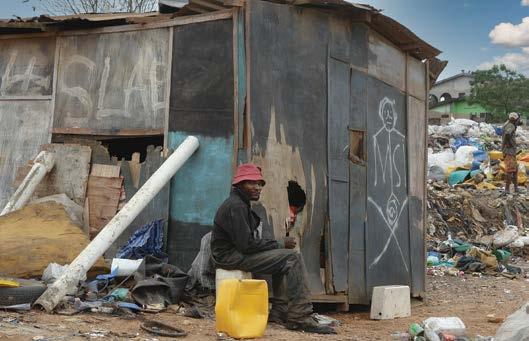
46
THOUGHT LEADERSHIP
dysfunctional billing system continued. The delivery of basic services, such as clean water, gradually ground to a complete halt.
Makana Municipality is also not unique: in 2017/18 only 18 of South Africa’s 257 municipalities received a clean audit from the Auditor-General15
Deteriorating infrastructure has a long history. Don Ross, who at the time of writing was a professor of economics at the University of Cape Town and University of Alabama, Birmingham, wrote in 2007 that South Africa had allowed its infrastructure to seriously deteriorate during two decades of under-investment in its maintenance and expansion. That would take us back to 1987!
In a piece titled On getting our money’s worth from infrastructure spending, he notes that government had at last committed funds on a level sufficient to reverse the neglect [the emphasis is mine]16. He adds that then President Mbeki had made repeated public remarks on how massive new infrastructure investment was the cornerstone of the government’s poverty alleviation campaign, and then Finance Minister, Trevor Manuel, attached specific numbers to this commitment, totalling some R121.8-billion.
Government also set certain objectives to this commitment, one of which was to ensure that infrastructure was adequate to allow South Africa’s economic growth to keep pace with its potential. Professor Ross says that at previous investment levels this was not true for the road network, rail network, energy sector or ports.
However, Professor Ross goes on to record how the funding for infrastructure is not getting translated to actual projects. At the time of writing, four provinces had spent less than 75% of their budget due to capacity constraints. In addition, he argues that there were serious problems in the awarding and management of procurement tenders. Of particular interest to this piece, is that he argues then that strategic planning had been relatively absent from infrastructure development implementation in South Africa for about 20 years.
Some of the solutions for solving the energy crisis in South Africa include, as one author has argued, the need for deep change [the emphasis is mine], citing political and leadership changes at the departments of mineral resources and energy and public enterprises as part of the required changes17
In 2021, President Cyril Ramaphosa, acknowledged the lack of technical skills and project management capacity as one of the main obstacles to South Africa's infrastructure investment18. State-owned companies attribute contractions in investment to, among other, Covid-19-related restrictions in the construction sector, long-standing project delays and credit rating downgrades19. Numerous calls are made for increased investment, with the South African Institute for Consulting Engineers (SAICE) calling for an improvement from 13.7% of GDP as it was in 2020 to at least 30% by 203020.”
REFERENCES
1 Vermeulen, J. 2023. Big problem with Eskom’s grid – South Africa faces 10 more years of power cuts.
2 Ibid.
3 Ibid.
OTHER REMEDIES
• Reducing habitual underspending of infrastructure budgets by public service providers.
• Introduction of revised procurement regulations to minimise recurring revenue management failures.
• Sensitising government infrastructure departments and stateowned companies to the importance of economic and social infrastructure and the negative consequences of infrastructure neglect when renewal or replacement is delayed.
• Teaching decision-makers and their support teams the importance of maintenance and lifecycle planning.
• Encouraging decision-makers to enhance capacity within their departments by highlighting the role of the civil engineer in service delivery through infrastructural planning, design, construction, operation and maintenance.
• Strategic coordination at the level of local projects across infrastructure sectors (roads, power, hydro, housing, etc) with respect to kinds of objectives.
CONCLUSION
Popular news articles and social media are hardly a source that can be used for developing major theories. Nonetheless, they do offer an immediate snapshot in time of infrastructure failures and possible causes. But can it really be that in all these country’s facing infrastructure challenges, under-investment, under-spending, lack of awareness, poor project management and corruption, among others, is the cause?
To unpack this further, more in-depth studies need to be reviewed. For the next think-piece, I will analyse studies and other peer-reviewed research to determine whether there is substantiated evidence from which a theory for infrastructure failure can be developed.
4 Dayimani, M., 2022. “Durban among several KZN areas facing water crisis as load shedding downs infrastructure.”
5 Palmer, S. 2022. “Auckland beaches overwhelmed by faecal bacteria after heavy rain.”
6 Wilkinson, S. 2023. “Flood warning: NZ’s critical infrastructure is too important to fail – greater resilience is urgently needed. In The Conversation, February 13, 2023.
7 Venuto, D. 2022. “The front page: floods, wastewater overflow and missing fluoride: what will it take to fix NZ water?” - NZ Herald
8 McFarland, M. 2021. “2021: When infrastructure got its due.” In CNN Business.

9 Kane, J. 2019. “Aging and in need of attention: America’s infrastructure and its 17-million workers.” In Brookings Institute, April 16, 2019.
10 Cokayne, R., 2023. “Construction industry encouraged by infrastructure development progress.”
11 Bulbulia, T., 2021. “Government commits to improving infrastructure spending.”
12 Bulbulia, T., 2021. “Government commits to improving infrastructure spending.”
13 Ross, D., 2007. “On getting our money’s worth from Infrastructure Spending”. Retrieved from: http://www.sibita.co.za/
14 Kotze, J., 2020. “Landmark court ruling highlights crisis in SA’s cities and towns.
15 Kotze, J., 2020. “Landmark court ruling highlights crisis in SA’s cities and towns.“

16 Ross, D. 2007. “On getting our money’s worth from Infrastructure Spending”. Retrieved from: http://www.sibita.co.za/
17 Ibid.
18 Ibid.
19 Bulbulia, T., 2021. “Government commits to improving infrastructure spending
20 Cokayne, R., 2023. “Construction industry encouraged by infrastructure development progress.”
47 THOUGHT LEADERSHIP
DQS Academy

Based on the same customer focused service excellence approach that we operate within our certification division, DQS Academy is an accredited training provider that offers training to suit a variety of needs in a range of ISO standards.
professional level related to ISO standards in IT Risk, Risk Management, Business Continuity Management, Food Safety and Energy Management, as well as other key business sector standards.
Choose from a range of short courses at varying competencies in Safety, Health, Environment and Quality as related to ISO 45001, ISO 14001 and ISO 9001 as essentials for a business, SHE and Environmental management to other short courses facilitated at a
Awareness/ Facilitation/ Implementation/ Auditing
ISO 9001:2015 Quality Management
ISO 14001:2015 Environmental Management
ISO 45001 Occupational Health And Safety
ISO 22000:2018 Food Safety Management
ISO 31000/ ISO 31010 Enterprise Risk Management
ISO 50001 Energy Management
ISO 55001 Asset Management
ISO 22301 Business Continuity Management
FSSC 22000 Food Safety System Certification
ISO 39001 Road Traffic Safety Management
ISO 37001 Anti Bribery Management
ISO 27001 Information Security Management

ISO 22716 (GMP) Good Manufacturing Practice
ISO 28001 Supply Chain Security
Ethical Trade Auditing and
Specialised Risk Assessment & Analysis Modules
Asset Management Principles and Applications
FMECA/ Failure Mode and Effects Criticality Analysis
HIRA/ Hazard Identification and Risk Assessment
SWIFT/ Structured What If Techniques
HAZOP/ Hazard and Operability Study
Bow T ie Risk Assessment/ Analysis
Baseline Risk Assessment
Hazard Identification
HACCP and many more ...
Our seasoned and experienced trainers will provide you with value added tuition across a range of business focused ISO standards preparing you at either at an introductory overview, implementation or internal audit level of competence to be able to usefully apply an ISO standard within your business operation. Various
eLearning trainings including, GRI, ESG & AccountAbility's: AA1000 courses.
many more...
Phone: +27 (0) 11 787 0102 Email: academy.sa@dqs.de www.dqsacademy.co.za
VIRTUAL TRAININGS APRIL 2023

CLASSROOM TRAINING

Early bird Discount 2.5% for payment 7 days before commencement date ISO 14001:2015 Awareness 1 day R1 904 excl VAT 03 Apr 2023 ISO 14001:2015 Implementation 3 days R4 914 excl. VAT 04 - 06 Apr 2023 ISO 50001 Energy Management 5 days R17 250 excl. VAT 17 - 21 Apr 2023 ISO 14001:2015 Lead Auditor 5 days R8 575 excl. VAT 17 - 21 Apr 2023 Integrated Management Systems (IMS) Combo 5 days R9 950 excl. VAT 17 - 21 Apr 2023 Core Tools Training 3 days R7 950 excl. VAT 24 - 26 Apr 2023 Root Cause Anaysis 3 days R5 990 excl. VAT 24 - 26 Apr 2023
MINIMUM 8 DELEGATES REQUIRED ISO 31000 Risk Management 4 days R6 990 excl. VAT 03 - 06 Apr 2023 IMS Awareness and Implementation 3 days R7 020 excl. VAT 11 - 14 Apr 2023 IMS Internal Auditor 5 days R8 550 excl. VAT 21 - 24 Mar 2023 Occupational Certificate: Occupational Health & Safety Practitoner NQF Level 5 18 months R45 653 excl. VAT Starting 23 Mar 2024 Simply leveraging Quality. www.dqsacademy.co.za academy.sa@dqs.de +27 (0) 11 787 0060 DQS Academy Courses For a full list of our courses, feel free to download our training schedule below.
www.greeneconomy.media ENQUIRIES Contact Alexis Knipe: alexis@greeneconomy.media www.greeneconomy.media



















 Alexis Knipe Editor
Alexis Knipe Editor





























































































 BY LLEWELLYN VAN WYK, B. ARCH; MSC (APPLIED), URBAN ANALYST
BY LLEWELLYN VAN WYK, B. ARCH; MSC (APPLIED), URBAN ANALYST
















